#it's a western fantasy time travel book
Explore tagged Tumblr posts
Text
It's literally impossible for N. D. Wilson to write a book that ISN'T absolutely fire
#the trilogy i'm reading right now is called outlaws of time#it's a western fantasy time travel book#and they're also hanging out with the angel of death#so. you know. check it out if that sounds at all interesting#outlaws of time#n d wilson
8 notes
·
View notes
Text
If I had a nickel for every time I read a really good m/m romance adventure where one romantic lead is described as being slender, with black hair, abnormally pale, with long slender fingers, incredibly intelligent and has a supernatural talent that adds to their competence and the other one is a really tall, very muscley war-tested fighter and they fall in love while trapped by mysterious technology from a different far-advanced culture and they realize they solve problems and survive better together and one of the puzzles is a maze of mostly white glowing corridors I would have 2 nickels.
Which isn't a lot but it's weird that it happened twice.
#mist [unlimited]#mist#which is a scifi time travel danmei#and#paladin's hope#which is a western dnd style high fantasy#like the books are very different#but also#i apparently have a type
21 notes
·
View notes
Note
Do you have any tips for deciding whether to use first or third person and present or past tense??
1st vs. 3rd Person | Present vs. Past Tense
1st Person is Best Used When...
The antagonist is abstract/is a psychological barrier that must be overcome
It's easier to weave backstory/info with experience.
Immediacy and toppling high stakes are important for the reader to keep rooting for your MC (like in the case of many fantasy novels)
You have an unreliable narrator.
You struggle to have a consistent tone/perspective. (third person not executed well will easily get confusing)
For literary fiction
3rd Person is Best Used When...
You have multiple MCs, following them more or less equally throughout.
You have freedom to move from wide, establishing views and closed-in views - this is good for conveying the theme.
You find yourself injecting too much of yourself in your writing and wish to prevent this.
You want the reader to view the MC more objectively, sometimes the narrator even offering commentary.
You wish to make use of dramtic irony (the reader knows more than the MC)
Present Tense is Best For...
The majority of novels are written in the past tense, and would be the easier one to execute if you're a first-time writer. However, present tense is certainly not inferior.
It feels like a movie: it allows you to mimic the action and suspense found in film.
It intensifies emotions: it gives the feeling of "we're in this together", the reader experiencing things with the MC side to side.
Works well with Deep POV: Deep POV uses third person narrators like 1st person, sticking with one character's mind for closeness.
Best for short-time-frame stories with constant action.
Works well for unreliable narrators: Since the narrative is so close to the action, it is easy to have a narrator that leaves out details.
However...
Readers can feel "claustrophobic, always pressed up against the immediate" (Philip Pullman quote)
Time shifts can be awkward - you're locked in the present more or less; unless you use flashbacks/dreams (which are disruptive)
It's harder to execute because you need to capture the texture of the present while acknowledging that the past and the future still exist.
It mimics film - you cannot just jump characters, speak directly to the reader or do time skips.
Books written in present tense (and are still good!)
The Hunger Games series
Bleak House by Charles Dickens
Rabbit, Run by John Updike
Ulysses by James Joyce
All Quiet on the Western Front by Erich Remarque
Fight Club by Chuck Palhniuk
The White Queen by Philippa Gregroy
Time Traveler's Wife by Audrey Niffenegger
─── ・ 。゚☆: *.☽ .* . ───
💎If you like my blog, buy me a coffee☕ and find me on instagram!
💎Before you ask, check out my masterpost part 1 and part 2
💎For early access to my content, become a Writing Wizard
#writers and poets#writers on tumblr#creative writing#writeblr#poets and writers#let's write#helping writers#creative writers#writing#resources for writers#writing practice#writing community#writing inspiration#writing ideas#writing advice#on writing#writer#writing prompt#writerscommunity#writing ask#writing asks
192 notes
·
View notes
Text
Happy June!
To celebrate the fact that we are now officially one month away from the start of AU Roulette, have a post detailing the 36 AUs included in this year's challenge -- or don't, if you'd rather be surprised.
This year's AUs have been curated to be intentionally broad, in the hopes that they will encourage unique takes on each prompt and the creativity of the authors participating. You are welcome to write anything that falls under the umbrella of your assigned AUs, whether it's an original universe, a fusion inspired by another fandom, or something else entirely.
(What's AU Roulette, some of you might be asking? An explanation can be found here, along with the link to sign-up!)
Without further ado -- the AU list, under a cut:
Roleswap - Maybe you want to switch two characters' places, do a class-swap for a D&D fandom, try your hand at an age-swap fic, or you have another idea.
Superhero -- Invent an original universe or do a fusion with one of the many popular big-screen superhero stories. Play it straight and give your favorite characters cool powers, or try a deconstruction of the genre. With great AUs comes great responsibility
Gothic Horror -- Castles. Ghosts. Vampires. Drama. Love that conquers Death. Take your inspiration from classic literature or a newer entry in the genre, like The Locked Tomb books. But be sure to make things spooky.
Post-Apocalypse -- Will the world end in fire or in ice? Or maybe economic collapse, war, zombies, or one of many other options? You write what happens next!
Fairy-Tale -- Pick a classic tale from the Grimms, Hans Christian Andersen, Asbjørnsen & Moe, Charles Perrault, or another favorite author to inspire your AU, try out a more modern re-telling, or use fairy-tale elements to craft your own story.
High Seas -- Including but not limited to Pirate AUs and other Age of Sail adventures. Try out something more historical, or throw in as many fantasy elements as you'd like -- or a bit of both.
Time Travel -- For fixing mistakes, making things worse, or time loops. Or maybe you want to write a fusion inspired by a piece of popular time travel media, like Doctor Who.
Western -- Another AU where writers are free to do their history research or to lean into more outlandish genre conventions. Cowboys, cowgirls, and cowpokes all welcome, of course.
Mythology -- Write a story inspired by your favorite myths and legends, from a whole host of different cultures. Or maybe you'd like to try your hand at writing some epic poetry?
Coffee Shop -- A classic everyone knows and has strong feelings about. Play it straight or add a twist, whichever suits your fancy! After all, no one said where the coffee shop has to be...
College/Academia -- Are the characters in your AU students? Professors? Weary adjuncts? Throwing hands at a conference? Some mix of the above?
Theater -- Put those characters on Broadway or cast them in a disaster of a community theater production. Or a school play! All that really matters is the show must go on.
Ghost/Cryptid Hunters -- Maybe you want to write a story starring the next Scooby-Doo crew, or maybe there really is something strange in the neighborhood. Or maybe it'll never be clear what really happened -- it's your choice!
Secret Agent -- Code words, code names, you name it. Write a story about spies, cryptographers, or any other clandestine operators. Take inspiration from history or from James Bond. Just don't spill your secrets too soon.
Detective -- Whether you're writing the world's greatest detective or someone who just can't get a clue, play up the mystery! Use a classic locale like 221B Baker Street or invent your own.
Cyberpunk -- Time to write cyborg identity crises and fight the machine (literally)! Take inspiration from classic media like Neuromancer or Blade Runner or make a totally new cyberpunk universe of your own creation.
High Fantasy -- Elves and dwarves and gnomes, oh my! This AU could encompass everything from Middle Earth to D&D AUs to your favorite high fantasy books you read over and over as a kid. Or maybe you have your own spell to weave.
Band/Musicians -- Whether you decide to make the characters in your AU famous pop stars, part of an orchestra, students at a conservatory, jamming together in their garage, or otherwise musically-inclined, have fun with it!
Reporter/Journalist -- For everything from local anchors and newspaper staff to big-league investigative reporters. Write characters who'll do anything to get a scoop or with a strong sense of justice -- it's your call!
Cosmic Horror -- You don't have to love Lovecraft to get creative with this AU. Make characters comprehend the incomprehensible, send them messages from beyond the stars, and get a little creepy.
Heist -- Will you write a story about master thieves? Vigilantes righting some wrong? What's being stolen and why? Try a Leverage AU or a caper of your own making.
Space Opera -- The genre encompassing works like The Expanse, Imperial Radch, Mass Effect, and Star Wars, brimming with galactic empires, alien species, and chivalric adventures. Write a fusion set in the universe of your favorite work in the genre, or invent a new one!
Sports/Athletics -- Pick a sport, any sport -- whether a team game like hockey, an individual one like archery, a paired one like figure skating, or something a little unconventional, like roller derby or HEMA. Then it's ready, set, write!
Historical Era -- An AU type absolutely bursting with potential, from medieval romances to 1920s Prohibition AUs, to ones inspired by historical fiction like Les Miserables. Whatever era of history strikes your fancy, you can write it.
Road Trip -- Pack your favorite characters in a car and don't forget the snacks. Or maybe the spaceship, or something else if you're feeling adventurous. Where are they headed and why? Only you know the answer!
Space Exploration -- Whether you want to write modern-day astronauts, a futuristic Star Trek AU, or something inspired by the space race, the sky isn't even the limit with this AU.
Urban Fantasy -- For all your modern-with-magic settings. Write an AU inspired by something like Teen Wolf, Artemis Fowl, Buffy the Vampire Slayer, or much of Neil Gaiman's oeuvre, or invent your own world where witches and websites coexist.
Museum/Archives -- Have the characters in your AU working in the exhibits or behind the scenes, down in the collections or even as archaeologists or paleontologists. What secrets are waiting to be unearthed there?
Hospital -- A surprisingly flexible AU option -- are the characters working there, or the victims of some unfortunate accident? Or maybe it's a bit of both. Take it wherever you feel like.
Camping/Wilderness Survival -- Could be anything from a fun summer camp or camping trip to a nightmare survival scenario. Write everyone having s'mores around the campfire or something inspired by media like Yellowjackets, where they might be having... something else.
Steampunk -- A fantastic opportunity to get creative with your worldbuilding. Try your hand at some alternate history, or invent a world of airships and other flying machines of your very own.
Shapeshifter -- Can the characters in this AU turn into anything they want? Or maybe they're more limited, like selkies -- even unable to control their shapeshifting at all (can I get an "awoo" from the werewolf fans?)
Classic Literature -- An AU somewhat more dependent on fusion ideas, but still very flexible! Pick a favorite classic book or play and let it inspire your writing!
Dystopian -- Create your own awful society or let a favorite piece of media guide you, like writing a Hunger Games AU. Will the characters break the cycle, or end up trapped in it?
Renaissance Faire -- A recipe for chaos. Write a bunch or faire-goers or have the characters in your AU working at the faire! Adventures await.
Scientist/Mad Science -- Write characters as normal biologists, physicists, and chemists, the next Frankenstein, or as hapless experiments themselves!
119 notes
·
View notes
Text
okay random 4am rant time, don't take it too seriously, but: people need to recognize there's a difference between "bad worldbuilding" and "worldbuilding styles you personally don't like."
bad worldbuilding is, for example: internally inconsistent, bigoted, or something else that messes up the plot or characterization of the story itself. sloppy. careless.
things that are *not* bad worldbuilding:
minimalism.
i've been thinking about this in the first place because i saw a post about the Murderbot Diaries a while back (don't know who made it, don't care; this ain't personal) saying the worldbuilding in those books is bad and lazy. to me, as an avid sci-fi reader and writer, that is clearly not true. but i understood why they thought this. the series uses extremely minimalist worldbuilding which intentionally withholds a lot of detail, in a way that is consistent with the (nonhuman, robot, depressed robot) first-person POV. this could also be a feature of the author's writing style in general—i haven't read her other works—but i wouldn't bet too much on it.
the signature of intentional minimalism is that there *are* details about the speculative setting—they're just doled out very thoughtfully and sparingly. the intent is to leave you a little hungry for more. it's to make you think very carefully about the details you do have. this is best suited to stories that already have elements of psychological and/or mystery plot types. the worldbuilding you do see should still be believable, internally consistent, and have interesting implications if you think about it a bit. but you are for sure going to have to think harder to get it.
if you're not in the mood, i will concede, a minimalist style definitely comes off as a bit dry. if you are in the mood, it's relaxing.
whimsy.
this is a big one for sci-fi fans in particular. see: the constant debate about whether any particular story is "hard" or "soft" sci-fi, and whether soft sci-fi is bad, etc etc. but worldbuilding doesn't have to be realistic to be good. you're allowed to have Jedi and humanoid aliens and time travel in your sci-fi. you're allowed to have historical anachronisms and astrology and po-ta-toes in your fantasy. whether or not they're silly isn't the deciding factor on how "good" these worldbuilding elements really are.
the key thing is tonal consistency. you've got a serious high-fantasy setting with its own strict, un-Earth-like theology and magic system, and you throw Santa Claus in there? yeah, that's not gonna land well. but C.S. Lewis can get away with that in Narnia just fine. why? because the Chronicles of Narnia are whimsical children's stories with a strong Christian/Western mythological influence already, and their central conceit is a crossover between the mundane world and the magical world. of course Santa can cross over too. it's whimsical, but it's not actually random. (and if you ventured into straight-up comedy, you could get away with random too. as long as it's funny.)
the unreliable narrator.
i don't have a good example for this off the top of my head (maybe Murderbot again? idk, i'm sleepy, fill in your own) but i'll tell you how to recognize when this is done well.
by definition, an unreliable narrator has some key misconceptions about their own world. so how do you tell what's going on as a reader? how do you know the writer isn't equally confused?
you connect the dots. solve the puzzle. in practice this is similar to reading a minimalist setting—but instead of just sparse clues, you also have a boatload of red herrings. you can catch some of these misleading details by comparing them to your real-world knowledge and saying "wait, this doesn't add up." other times, the false clues intentionally trick you by subverting those real world expectations.
the trick is in the consequences. regardless of what the narrator says, their actions should still have logical consequences. there should be things going on that the POV character doesn't know about. the character will be forced to learn and adapt their narrative because of these shifting circumstances. you can catch them in a lie. the inconsistencies themselves tell a story.
...
i'm gonna stop myself there because this post is long and i oughtta be sleeping. just. this is a distinction worth making. is it really bad worldbuilding, or is it simply not the genre you're craving today? learn the difference for your own sake. you'll have an easier time realizing if a story is something you'll find enjoyable to read, regardless of its actual quality.
#long post#writing#worldbuilding#media literacy#media analysis#the murderbot diaries#the chronicles of narnia#Christianity mention#rant#sleep deprived
242 notes
·
View notes
Text
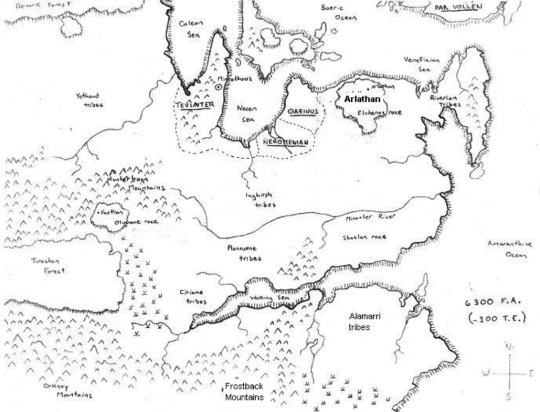
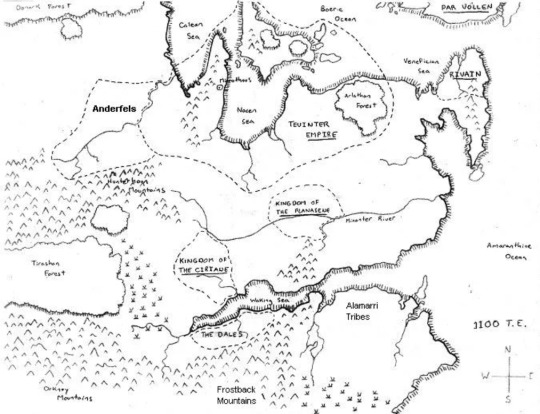
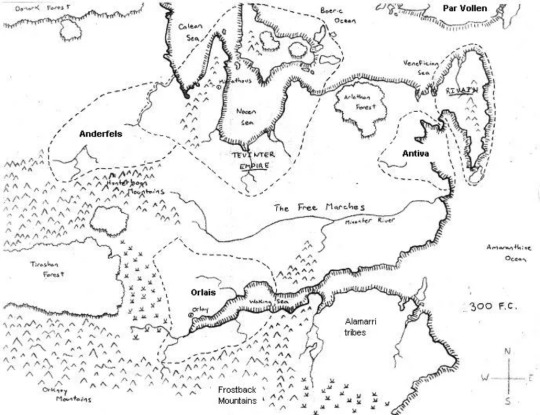


Image credits: David Gaider [source link below]
Article: 'Who is qualified to make a world? In search of the magic of maps'
"You're travelling with your imagination..."
An extensive feature article about maps, map creation and world-building. It refers to David Gaider and the team's early world-building and early-days process of creating the universe that would become Dragon Age. It includes this early series of original sketches of the map of Thedas through time that Gaider drew when the world was being created.
Excerpts under the cut (due to length):
"Dragon Age. That's the game Gaider was working on - or rather, it was the world he would dream up. Ideas had been swirling about what Dragon Age would be for a few months. The team knew it would be like D&D but would not be actual D&D, because BioWare was sick of licensed games at the time. They knew they were going for Tolkien rather than Conan or Diablo. "We definitely had at least some idea of the kind of RPG this was going to be," Gaider tells me when in a video call. But BioWare didn't have a world. One day, Gaider was handed a historical atlas of Europe and tasked with going away and coming up with a fantasy world for players to explore. And almost immediately, he sketched a map." - "What is it about a map that gives it magical powers to bind us and pull us in? I wanted to know more, and through talking to David Gaider and learning about his creation of the map for Dragon Age, I hoped I might find out." - "In fact, he corrects me, "I sketched a lot of maps." But they were the same map, replicated over and over, because in order for a world to make sense to Gaider, it needed history. "I drew this coastline and then made a bunch of photocopies of it," he says, "and did this series of sketches, like, 'Okay in this era, this is where people lived and where they migrated and created different cultures,' and those cultures changed over time as they got conquered. Much like the book of European maps I had, I was doing it in eras and forming an idea in my mind about how these groups all mingled together. David Gaider was kind enough to share his original sketches of the Dragon Age world with me, and in them, you can see an emerging flow of history. You can see the spread of the Tevinter Empire as the race of Men lands in the north and then begins to spread out. You can see, in the earliest images, there's still a kingdom of Elves in the forest of Arlathan, nearby. Then, they are forced out by the growing Tevinter Empire, south to the Dales, where we encounter them in the Dragon Age games, subjugated to being a kind of slave race. Tribes give way to kingdoms, and names we're familiar with begin to appear." - Caption on the sketches: "David Gaider's original sketches of the Dragon Age world. Wherever you see a name typed in, it's because it was changed by EA's in-house sensitivity team, which cross-checked place names with real-world names in case there was a clash. The area of Antiva, for example, used to be called Calabria, but Calabria is the name of a region in southern Italy. "Well, if you do something with the Calabrians that real Calabrians don't like, they might get upset," the sensitivity department at EA told Gaider. "So I was like, 'Oh fine, I'll change it,'" he says." - ""My feeling on history when it comes to worlds," Gaider says, "is that you need to have a lot of it." Without it, he says a world will feel like a facade. "Sometimes you'll see worlds where they've made only what is needed for their current story, and it's like an old Western set: it feels right, it looks right, but then you slowly get a sense of, 'Oh, there's nothing behind those doors.' Before he sat down to draw, Gaider already knew some of the geographical elements he wanted. He knew he wanted a topsy-turvy 'South was cold and North was hot' idea for the continent, to play with people's expectations, and he knew he wanted a large waterway - that he likens to the Mediterranean - carving its way far inland. Today, we know this as the Waking Sea, and it's an incredibly important feature in the Dragon Age games. Gaider also knew he wanted islands far up in the north, from which an unknown race could invade. "I knew that I wanted an 'other' race that would come along," he says, "which ended up being the Qunari." Gaider also knew he wanted untouched areas for adventure, like forests and mountains, just in case the game would need them. "I didn't want every place to be so civilised that when it came time for 'we need ruins' or 'we need massive wilderness', we've got nowhere to go because I've civilised the entire thing," he says."
"Because remember, the team didn't yet know where the game they were making would be set. That's why so much of the continent you see in the sketches is as yet unused in Dragon Age games - the series hasn't needed all of it by this point. Continents are vast, after all, and realising them in 3D for players to explore is a mighty task. "I guess in my head," Gaider says, "we would be probably either on the north of Ferelden, on what became the Free Marches, or maybe off in the west more towards the Tirashan Forest or the Hunterhorns. That was a very wild area and I was like, 'That's a good place for an adventure to be.' Atlas at hand, photocopies in front of him, Gaider set about his work of growing a game world from a bunch of maps, and with not a small amount of trepidation. There was a lot riding on the world after all; it was a far cry from the worlds he'd created and freely abandoned as a teenager. "This is going to form the foundation, ideally, for a lot of games," he says, "and a lot of people are going to do work [on it]. And the trepidation is like, 'I don't know what I'm doing.' I'm essentially the equivalent of a 13-year-old just going, 'La la la, I'm going to call this Ferelden!'" - "Some things bother David Gaider about the Dragon Age 1 map, still, and they occurred when artists prettied his sketches without his involvement. "Oh," he said awkwardly when they were presented to him. "I didn't want it to look like this, exactly." He says they added a lot more rivers and mountains, and flipping between his sketches and the Dragon Age: Origins map, you can see some have moved around, or gained prominence, and places like Redcliffe have shifted. Apparently people would take to the BioWare forums after the game came out to complain about the map's geography. "And I'm like, 'You know what? You got a point,'" Gaider says. This is mostly anger at himself, though, for not doing more about it. Similarly, he wishes he'd been able to sit down with artists and work out what the rest of the continent you don't see in his sketches looked like, so they didn't have to have "the continent just keeps going..."-like messages at the edge of it. "But to where?" Gaider says. But it speaks to something he's noticed in his decades working in games about artists and writers. "They really speak two different languages," he tells me. They process things differently and they tend to care about different things. There were reams of history and lore written in a "world bible" for the Dragon Age team, but getting artists to read it was another matter. They wanted clear visual cues, not piles of backstory. Dragon Age: Origins eventually found its setting in Ferelden, the kingdom in the bottom right bulge of the sketches, so it left a huge portion of the sketched world unused, which the team presumed no one would ever see. "We thought that was going to be the only one," he says of Dragon Age: Origins. "That's why when you get to the end of Origins, there's so many epilogues that cast off far into the future, which, if we'd known that we were going to keep going and keep going with history, we wouldn't have said, 'Oh, in fifty and one hundred years, this is going to happen.' I think we would have played our cards a little closer to our chest. EA apparently found the game very old-fashioned and thought no one wanted turn-based role-playing games like that any more, which of course now seems ridiculous given the success of Baldur's Gate 3. "Baldur's Gate just goes to show how wrong people are when it comes to industry wisdom," Gaider says."
-
"Nevertheless, when Dragon Age 2 eventually was green-lit, the scope of it, and the focus of it, would completely change. With it, BioWare and EA would push towards a console RPG experience that stopped and started less, and had more action-packed combat. And EA only gave BioWare 18 months to make it, so BioWare decided to make a much smaller, more tightly focused game. It seemed like a good idea at the time. "People at BioWare convinced themselves that the fans would be okay - it'll be fine if it's a smaller game," Gaider says. "And I don't know why we thought that was the case, but for a moment there in time, we were like, 'Yeah, sure, it'll be fine.'" As for the mapping, a tighter focus meant centering on one place rather than a whole region, so the city of Kirkwall on the Waking Sea became the heart of the game, and BioWare developed a time-jumping idea for the game so you could see it at various different points in your character's lifetime, which I still think is really neat. And because there wasn't a large region to explore, the game didn't need a sprawling map, so BioWare turned the map on its side to give Kirkwall some height and majesty instead. It wasn't particularly memorable, but it looked nice. The game didn't go down well. "Its highs were really high, and its lows were really low," Gaider says now. "It was very unpolished. If it even got six months more polish, I think the reception would have been a lot different." More importantly, it meant everything would need to change again for Dragon Age 3." - "In Dragon Age: Inquisition, the third game in the series, the map plays a starring role. It's built into the game world specifically so you and your Inquisition advisors can gather around it and push pieces about as you choose where to go next. Thematically, this fits neatly with the theme of running an organisation like the Inquisition, but the map was also required to cover a lot of ground. One thing BioWare knew the moment it started making the game was that it needed to be bigger than DA2. This time, the game would spread across areas of Ferelden we hadn't been to as well as some we had; up to Kirkwall and into surrounding Free Marches, and then west to the city of Orlais and onwards until it reached past the Waking Sea and arid desert land. But the sense of scale was an illusion. Dragon Age: Inquisition wasn't a continuous, open world, but a fragmented one, made up of a few open-world-like zones, some small parts of cities, and many 'you can't actually explore there, but you can read about it' text-window interactions. Again, this was Gaider's idea, to give the game "a feeling of breadth" without needing the art department to render it all in 3D. By the time Inquisition came out in 2014, the world of Thedas - the name an amalgamation of "the" and "Dragon Age Setting" by the way - had been reinterpreted for three games and touched by many pairs of hands. Gaider's writing team had plugged the holes he, as a single writer, couldn't fill, and the art team had shown us what the world looked like. There was even, fittingly, a Dragon Age encyclopaedia released, compiling the teetering piles of lore and backstory, and maps and imagery that BioWare created for it. People were now joining the team who were already fans of the series. This was no longer an imaginary world; Thedas felt real. And perhaps it no longer needed Gaider to steer it."
- "So Gaider left BioWare in 2016, having worked there for 17 years, most of it spent on Dragon Age. Really, he'd had enough of wizards and demons, and Anthem wasn't the tonic he sought. Eventually, he'd move all the way from Canada to Australia for a fresh start, where he'd start Summerfall Studios and make a role-playing musical called Stray Gods, which was released last year. That game, incidentally, only featured a small map for travelling between city locations. Today, he awaits the arrival of a new Dragon Age game - Dragon Age: Dreadwolf - like the rest of us, having had no direct input. It's an anxious wait, as you can imagine. "I was Mr Dragon Age for ten years," he says, "so there is a certain amount of attachment. I'm not sure how I will feel when Dragon Age 4 comes out. I have a hard time believing that if I play it, I won't spend a lot of the time second guessing any choices I see, like, 'Oh, hmm, I wouldn't have done that.' What if they bring back some characters that I wrote? They're going to Tevinter so what if Dorian's there? Gah! I don't know; I am of two minds as to whether or not I will even play it." "It makes me wonder about these people who create worlds, who draw them into existence - whether that's in a preliminary sketch or a lavish piece of artwork - and whether there's always a point where success comes with the consequence of ceding control. Had Gaider kept the world of Dragon Age to himself, a photocopied map, folded and stuffed in a back pocket, we'd never have played it. And had millions of people not played and enjoyed it, I wouldn't be writing about it now and have that feeling when I look at an image of one of Gaider's photocopies, that I'm in the presence of something special, something powerful. But it's no longer Gaider's map, and no longer Gaider's world. It's all of ours."" - "For Gaider, maps are snapshots of history, photocopied slideshows explaining how places came to be. And of course they are, because he was thinking about Dragon Age when he started in on maps, which meant that he was thinking about geography, sure, but also the passing of time, and the way the latter affects the former."
[source and full article]
#dragon age: dreadwolf#dragon age 4#the dread wolf rises#da4#dragon age#bioware#video games#longpost#long post#anthem
123 notes
·
View notes
Text
My current list of Tabletop Roleplaying Games.
13th Age
1879
A Grim Hack
Aberrant
Absolute Power
Abyss
Accursed
After The War
Anima Beyond Fantasy
Animal Adventures: The Faraway Sea
Apocalypse World
Arkham Horror The Roleplaying Game Starter Set
Ars Magica 4th Edition
Arzium
Avatar Legends Starter Set
Babes in the Wood
Badger + Coyote and their Daring Adventures 2E
BattleTech: A Time of War
Beacon Tabletop RPG
Beam Saber
Blades in the Dark
Bulldogs
Bunkers & Badasses
Cairn
Call of Cthulhu
Candela Obscura
Cantrip
Cats of Cathulhu
Chaos 6010
Champions Now
Collateral Damage
Contagion 2e
Cortex Prime Game Handbook
Cosmic Patrol
Cowboy Bebop Roleplaying Game
Coyote and Crow
Cthulhu Awakens
Cthulhutech
Cypher System
Daisy Chainsaw
Deathmatch Island
Defiant Role Playing Game
Denial & Yearning
Dialect
Dinocar
Dinosaur Princesses
Discworld RPG
Dragon Age Roleplaying Game
Dragonbane
Dread
Dream Machines
Dresden Files Accelerated RPG
Dungeon Crawl Classics
Dungeons and Dragons 3.5
Dungeons and Dragons 5e
Durance
Dwelling
Epitaph
Epoch
Essence 20
Fabula Ultima
Fantasy Age
Fate Core System
Fever Nights Role-Playing Game
Flabbergasted
Fragged Empire
Fratboys Vs
Girl By Moonlight
Glitter Hearts
Goblin Quest
Goblin Slayer TRPG
Gods of Metal: Ragnarock
Hannukkah Goblins
Have Axe, Will Travel
Hellfrost
Here, There, Be Monsters!
Hero Kids Fantasy RPG
Heroes Against the Darkness
Hopes and Dreams
Hounds
I’m the Badguy?!?
In Nomine
In the Ashes
Inevitable A Doomed Arthurian Western
Ink
Interns In The Dark
Into the Dungeon
Jiangshi: Blood in the Banquet Hall
Jordenheim
Katana-Ra
Kids on Bikes 2nd Edition
Killshot an Assassin’s Journal
Konosuba TRPG
Leverage The Quickstart Job
Lilliputian Adventure on the Open Seas
Little Fears Nightmare Edition
Lost Roads
Marvel Multiverse RPG
Mermaid Adventures
Micro rpg book
Modern Age
Monster of the Week
Moonlight On Roseville Beach
Mork Borg
Motel Spooky Nine
Musketeers vs. Cthulhu
Mutant Year Zero
My Mother’s Kitchen
Necrobiotic
Never Going Home
Night Shift: Veterans of the Supernatural Wars
Night Wolves
Numenera
Odyssey Black Tales
OneDice Pirates & Dragons
One More Quest
Ork! The RPG
Our Woodland Gods
Outcast Silver Raiders
Outgunned
Over the Edge
Overlight
Pasion De Las Pasiones
Pathfinder 1st Edition
Pathfinder 2nd Edition
Pathfinder Savage Worlds
Perils & Princesses
Pirate Borg
Power Rangers RPG
Prism
Psychic Trash Detectives
Punk’s Been Dead Since ‘79
Queerz!
Raccoon Sky Pirates
Raven
Rebels of the Outlaw Wastes
Reign
Rhapsody of Blood
Rivers of London
Ryuu Tama natural fantasy role play
Samurai Goths of the Apocalypse
Scum and Villainy
Shadowrun 5e
Shadows Of The Past
Shield Maidens
Shiver
Someone in this Tavern is a fucking mimic!
Spell The RPG
Squeeze
Star Trek Adventures Captain’s Log
Star Trek Adventures The Roleplaying Game
Star Trek Adventures Second Edition
Star Wars
Starfinder 1st Edition
Starfinder 2nd Edition
Stoneburner
Syma
Tangled
Temples and Tombs
The Bleackness
The Dark West
The Dread of Night
The Play’s the Thing
The Quiet Year
The Revenant Society
The Void
The Watch
Thirsty Sword Lesbians
This Discord has Ghosts in It
This house is Fucking Haunted
Thousand Year Old Vampire
Tomorrow City
Troika!
Unisystem
Urban Decay
Utopia
Vaesen
Vagabond
Valiant Universe
Variations On Your Body
Venture and Dungeon
Waffles For Esther
Wanderhome
Warcraft The Roleplaying Game
Werewolf the Apocalypse
What Lurks Above
What Lurks Beneath
What Lurks Beyond
World Ending Game
Yazeba’s Bed & Breakfast
Xianta Cyber Wuxia
Xoe Microplayer
Zweihander
I'll update this list as I get more. Feel free to send me ideas and also reblog this!
#ttrpg#tabletop#tabletop rpgs#ttrpg community#powered by the apocalypse#dming#roleplaying games#board games#game design#card games#gaming#dungeons and dragons#pathfinder#starfinder#call of cthulhu#My Games List
18 notes
·
View notes
Text
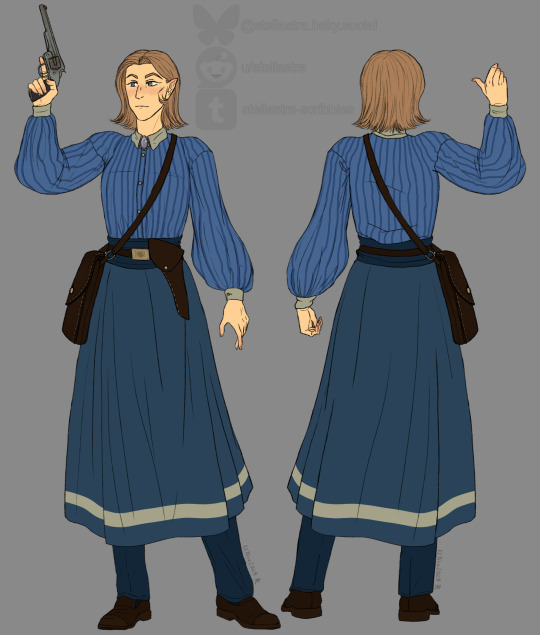
Finally completed the outfit reference for Jayna Stiles, a half-elven NPC follower from Arcanum: Of Steamworks and Magick Obscura.
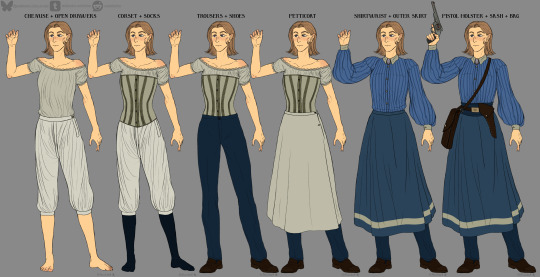
Outfit breakdown (or "outfit onions" as I like to call them lol~)
I really like Jayna Stiles and her backstory + goals of becoming a technological healer. I'm also a sucker for 19th-century fashion and I have an unhealthily large collection of reference books and a bunch of files saved from online museum collections (I've got about 22+ gigabytes of refs downloaded from the Library of Congress alone haha I need more hobbies).
Back on track, I really just wanted to design Jayna an outfit that suited her character more than her in-game sprites while also being practical for travel/adventuring.
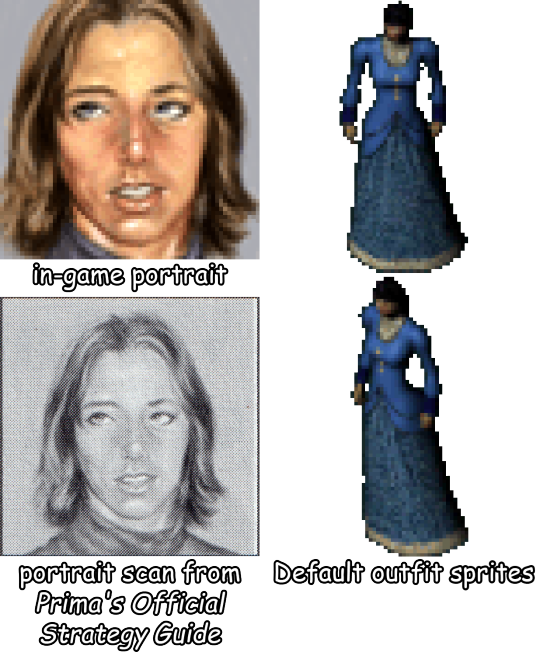
More unrestrained detailed design ramblings below the cut~
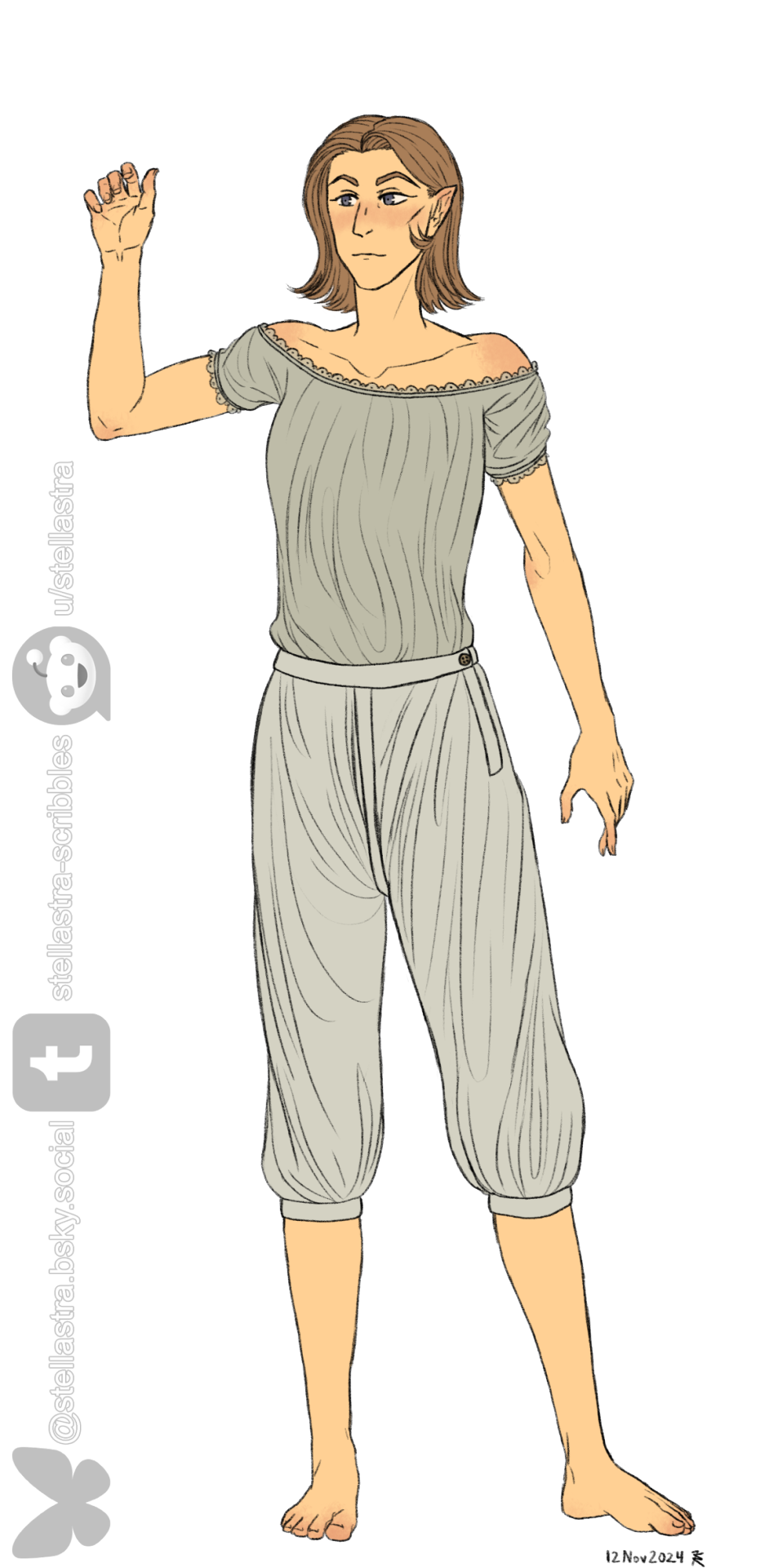
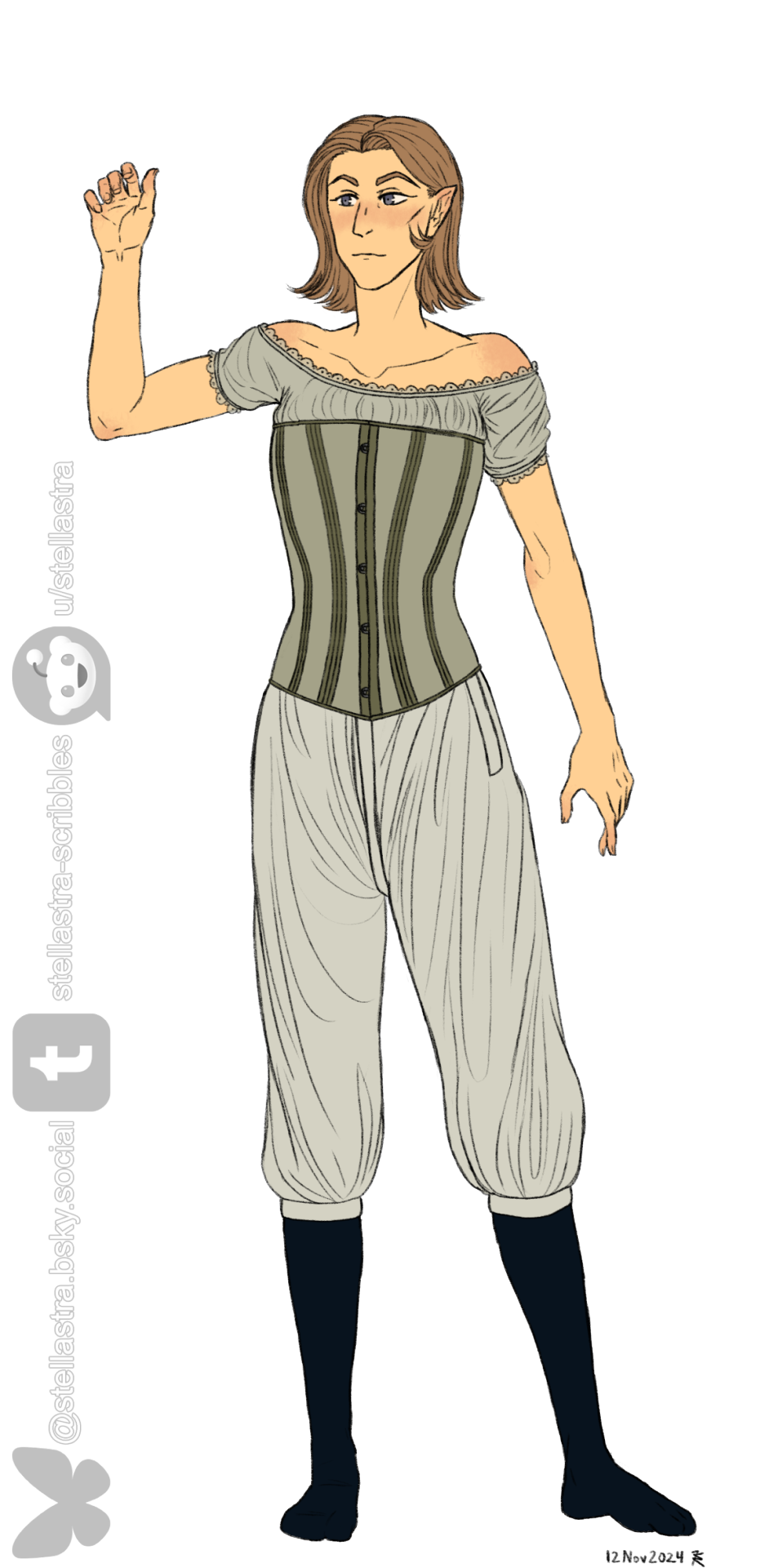
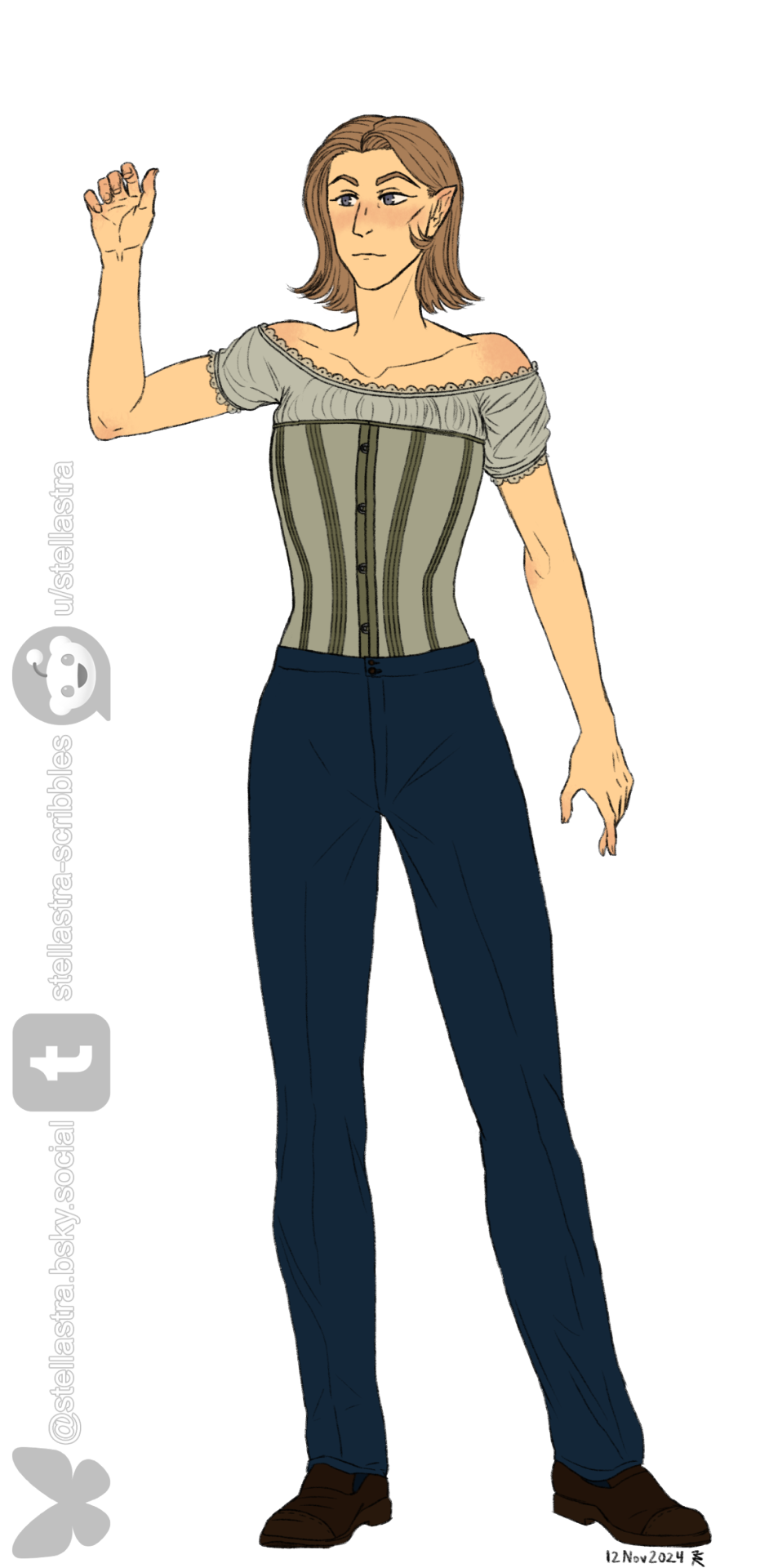
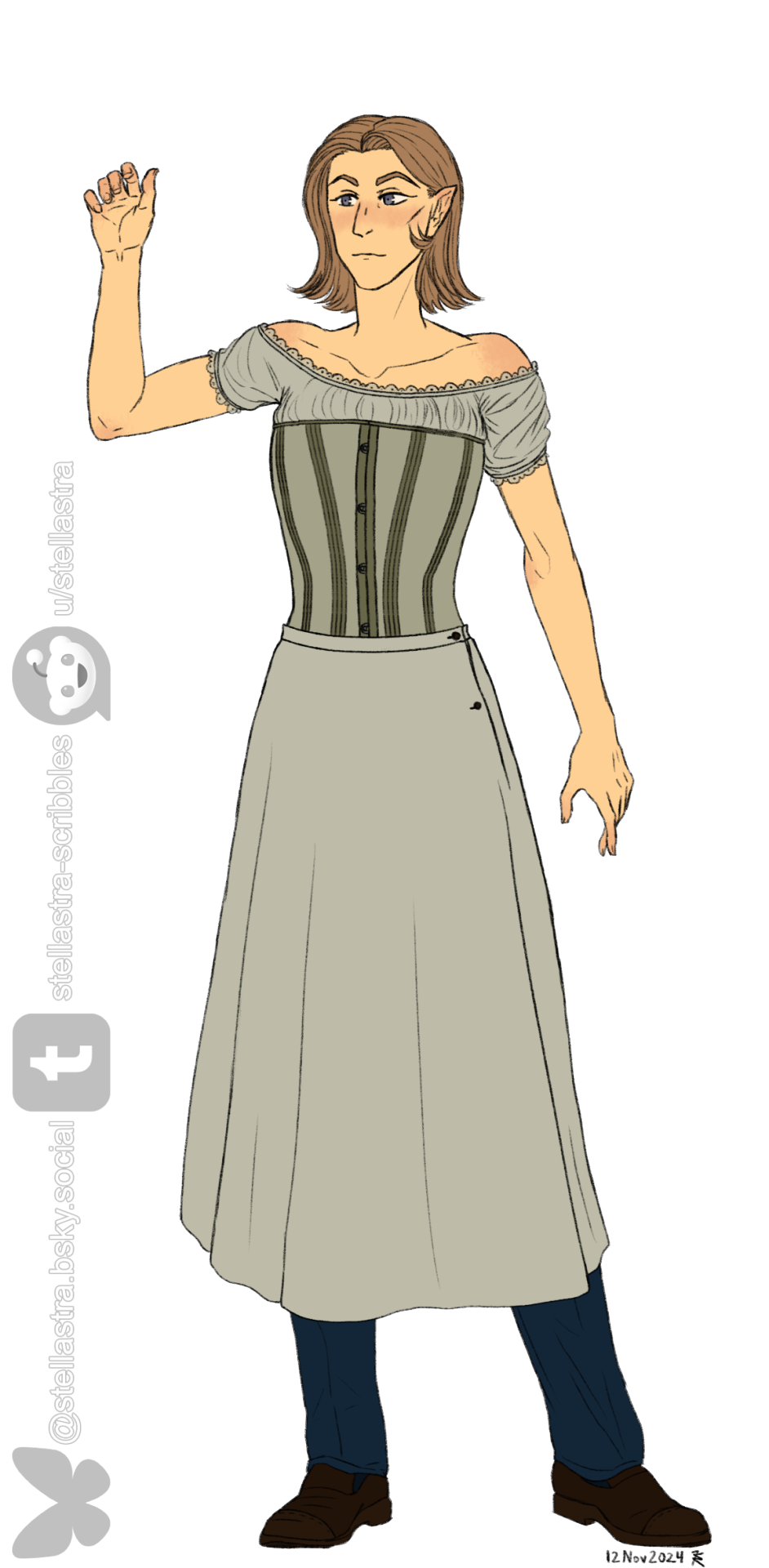
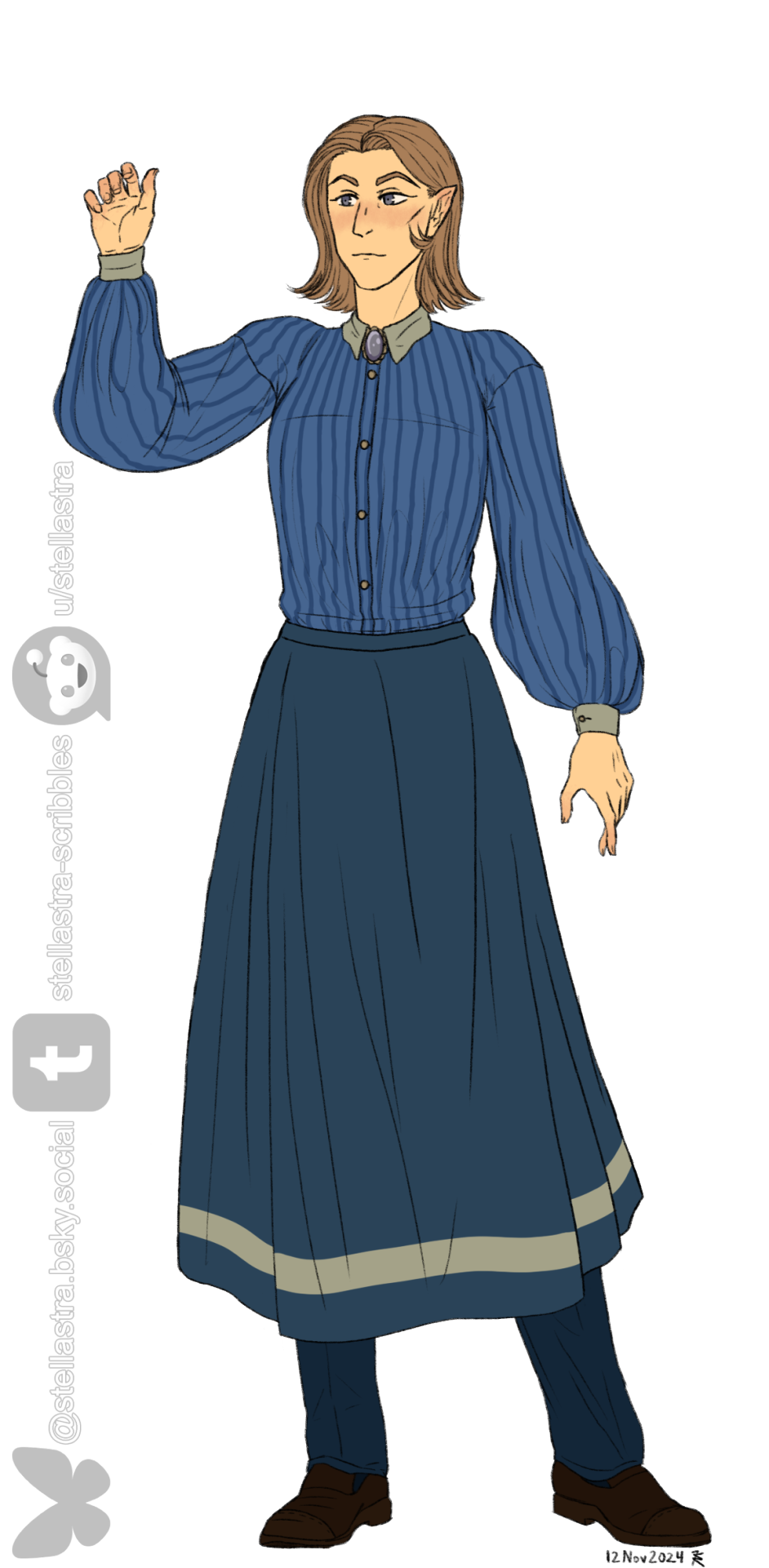
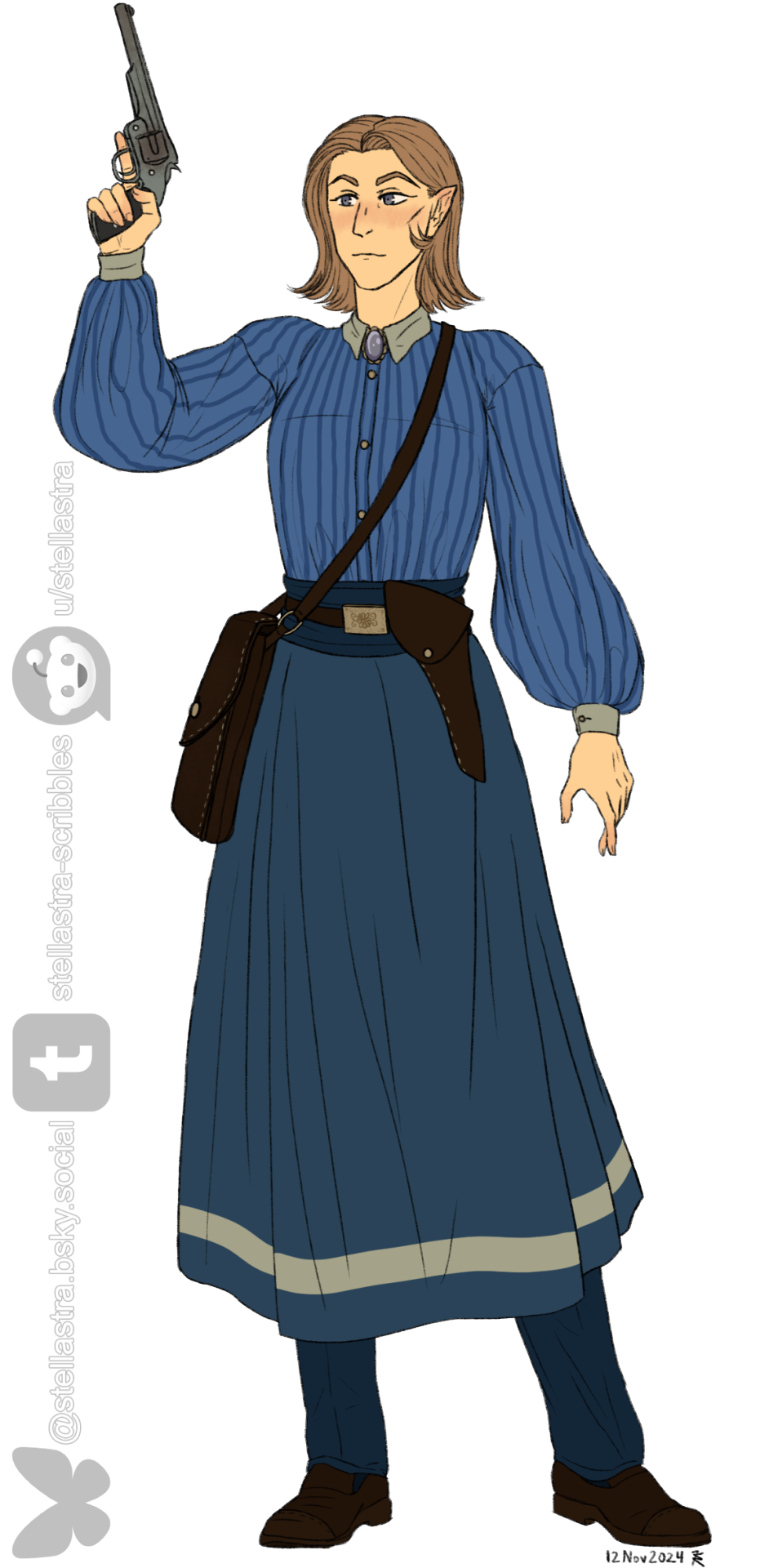

Individual layers. I pulled most of her colors from her default outfit.
Since Arcanum's starting year is 1885, I usually picture the "modern" sense of fashion in big cities like Tarant and Caladon taking cues from real life 1885-1890s western fashions (to give myself some leeway with references). Smaller towns can be a bit more dated, but I try not to go back further than the 1870s in most cases.

However, for a character like Jayna, who hails from Dernholm, I gave her clothing from references dating back to the 1850-1860s. I did this because Jayna says in her recruitment dialogue that "[her] parents weren't wealthy people, and [she doesn't] make much money here in Dernholm," so I took this to mean that she likely wears clothing to last, wearing hand-me-downs, makes her own clothes, and mending it over the years rather than buying new clothes.
Given that Dernholm (+ the Kingdom of Cumbria in general) isn't in the best state when the game starts, they may be behind the times and the latest fashions take longer to reach Dernholm.
Gar: “Alas, poor Dernholm! Once home to the legendary Dragon Knights, it has fallen on hard times since Praetor became king some 60 odd years ago. He despises all technology, and I think he's recently become sour on magick as well.”
Herkemer Oggdoddler: “For two generations Cumbria languished as an economically abused and technologically impaired backwater in the shadow of Tarant. Its once fine capital, Dernholm, has become a ruin.”
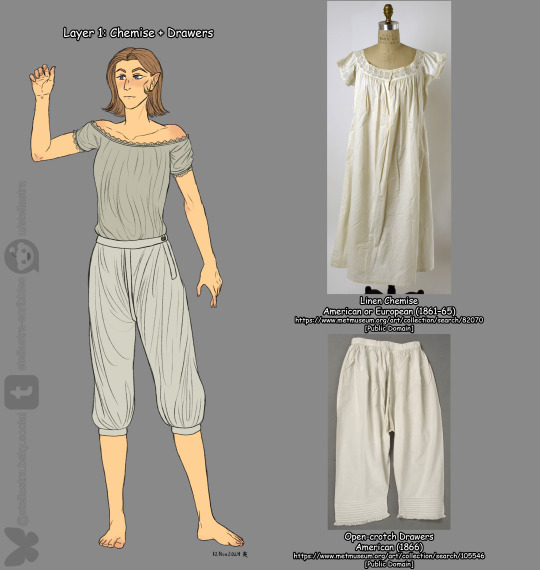
Layer 1 - Chemise + Open Drawers. I deliberately drew the drawers as fairly loose so as to not expose her without having to redraw the pose or resort to "Barbie doll anatomy."
Various resources demonstrated the chemise being tucked into the drawers or worn fully untucked/loose, but I drew it as tucked-in for the sake of reference visibility, so perhaps either one works in practice.

Layer 2 - Corset + Socks/Stockings. I picked a more "contemporary" (1880s) design for the corset as I imagine it would be a more custom-fitted garment. Plus, anyone who has ever worn bras will attest that a bra that properly fits is comparable to a good pair of shoes: never cheap out on it because if you take care of it, it will take care of you. Perhaps that same logic can be applied to corsets in ye olden days and historically-inspired fantasy settings.
For Jayna, despite the simplistic design, it might be one of the few luxuries she can afford for herself given the necessity of the garment for bust support.

Layer 3 - Trousers + Shoes. I was inspired by vivandières and Dr. Mary Edwards Walker, who typically wore trousers beneath their skirts. Dr. Walker was a "surgeon, women’s rights advocate, abolitionist, and spy, [and] the first female U.S. Army surgeon during the Civil War." Since Jayna is an aspiring technological healer, I feel like an allusion to Dr. Walker and her practicality was appropriate.

Layer 4 - Petticoat. It's just something to fill out the skirt volume a tad. I considered adding a corset cover in this layer but I did like having the upper outline of the corset somewhat visible in the shirtwaist layer to illustrate her living situation (aka she doesn't have one or just has a poor-quality one). As a modern-age woman, I think this this all already looks like a laundering nightmare to wash by hand.
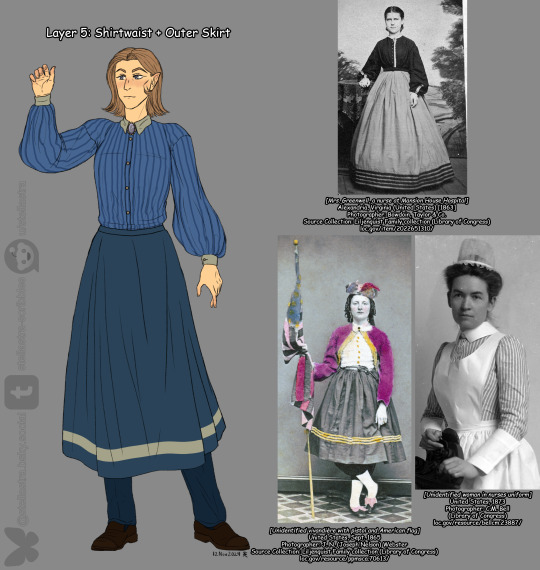
Layer 5 - Shirtwaist + Outer Skirt. I really like the shape of the 1860s Garibaldi blouse's sleeves (I think these are bishop sleeves? correct me if I'm wrong...) and the stripes allude to some 19th century nurse uniforms. I initially went for a plaid pattern but that was a pain to draw and using a pre-existing plaid brush/pattern just didn't look as good as I wanted it to be.
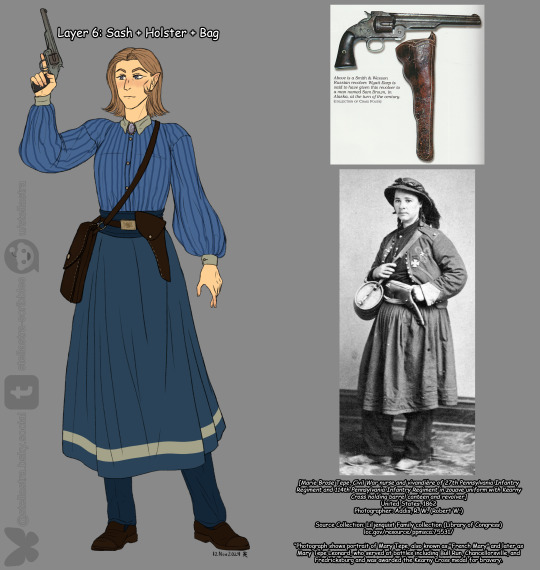
Layer 6 - Sash + Pistol Holster + Bag. Given Jayna's goals of becoming a tech healer, I took design cues from vivandières, who were 19th-century women attached to military regiments, with a few known vivandières being nurses (like Anna Etheridge).
However, rather than lifting the vivandière look completely, I imagine Jayna would attempt to replicate the silhouette with her own clothes. The bag is a bit of an amalgamation of various 18th-19th century hunting/frontier bags, so I apologize that I don't have a direct reference image.
---------------
Of course, in the end, I did take some liberties with the outfit so it's not completely historically-accurate, but that's okay since Arcanum is a fictional universe.
I guess I should've prefaced that I'm no expert on historical fashion, just a casual enthusiast who thinks "ooh old dress is pretty!"
I just wanted to see how far I could go before I had to make some concessions, such as:
Jayna's hair is short and worn loose while irl Victorian women typically had long hair and wore them up (there were documented exceptions of course). Many portraits for both female player characters and female NPCs across all in-game races show short hair and loose long hair, so let's just assume that 19th-century Arcanum has more relaxed feminine hair standards compared to the real-life 19th century western world. Also, irl 19th-century rural women did sell their hair for money, so maybe there's something to apply to the world of Arcanum with that. Or maybe the short-hair craze just hit Arcanum a few decades early *shrug*.
I initially planned to give her gloves, but many resources show vivandières not really wearing them, preferring to go barehanded.
The clothing colors may be a bit too saturated for the era I took inspiration from, but I wanted to stay somewhat faithful to Jayna's original sprite colors.
I did simplify some garments down for the sake of me having to draw enough layers as it is lol. Sorry if the lace wasn't fancy enough or that she doesn't have headwear. ¯\_(ツ)_/¯ Sometimes you just wanna finish a project and be done with it.
hoo boy, that was a lot
Thank You For Coming to My TED Talk :)
Now go play Arcanum: Of Steamworks and Magick Obscura~
#stellastra's art#Arcanum#arcanum of steamworks and magick obscura#arcanum: of steamworks and magick obscura#Jayna Stiles#half elf#historical fashion#steampunk fantasy#character design#victorian fashion#19th century fashion#unashamedly tagging this bc this game doesn't get enough love#to the like 10 or so Arcanum fans here on tumblr - this is for you!
12 notes
·
View notes
Note
How many adaptions has a bad ending for the group, like I remember there was one where Sun Wukong murdered Tang Seng in his sleep and he didn't remember afterward?
That is from a light novel Bio of Wukong. And while that was the height of JTTW angst popularity it still didn't get that adapted into any movie/show.
I can't say that there is any 'bad' ending because while that could work well in maybe a literature medium. Books allow for a long time to build up characters, exposition, and suspense without needing to worry about limitations like runtime or production costs. I can't say that there are a lot of shows that are bold enough to have a 'bad' ending really as movies only have a limited time, especially for something like JTTW that is always seen more as a Fantasy/Adventure story than anything dramatic. Not saying that JTTW can't have horror elements or dramatic elements, but that it just isn't common that this is the main element.
That being said that there are two pieces of media that are inspired by Bio of Wukong. One being a movie by the same name "Bio of Wukong" where we see Wukon's whole mountain being killed off and that even shows Wujing and Bajie's past lives Juanlian and Tianpeng being killed off as well. While this is the most 'bad' ending movie it isn't really the end as it more takes place right before Wukong is about to be trapped under the mountain. Moreso this takes what is already there, the Burning of Flower Fruit Mountain, and is the focal point of the movie. However, while it ends with Wukong trying to take on Heaven one more time we never see the actual journey so I can't say it is a 'bad' ending when that isn't shown.
Another that can be a 'bad' ending somewhat is from where the Bio of Wukong light novel is actually inspired by which is the Chinese Odessey. This one Wukong does try to kill Sanzang, but fails, and he gets trapped by Guanyin where in the next life he turns into Joker. Sanzang does end up 'dying' in that verse. However this is a time-travel movie so Joker does go back in time and he does become Wukong again and then he does go on the journey so that is also not really a 'bad' ending.
A better one could be considered Westward the animation series. This one is where by the end of the journey Wukong is killed in heaven and Sanzang, Bajie, and Wujing are separated after the scripture are lost. Pretty much someone evil has secretly taken over heaven and what to use the scriptures for evil stuff. Now Wukong dead, Sanzang, Bajie, Wujing, Bailong (Ao Xue), and now BaiLang a wolf demon are on a mission to bring back the scriptures to Western Heaven so that the evil people don't get their hands on them (also the scriputres have cultivated into a dragon girl). This one is more adventure/action but it is a 'bad' ending for the journey officially which leads to this SECOND journey to fix it.
Also a strange addition but God of High School the anime. You would never guess but the main character is Sun Wukong without his memory and apparently, the gods of that world lied to him and his pilgrimage about the scriptures and it was all a ploy for 'buddha' or the god claiming to be him to eat Sanzang and become all powerful himself. Sadly ends with Bajie and Wujing dying and Wukong has to eat Sanzang himself in a last-minute desperate move to defeat the evil deity which does work but leaves Wukong eventually going to earth and becoming 'human'. Kinda insane but that is a 'bad' ending that is only revealed like after 400 chapters in.
#anon ask#anonymous#anon#jttw#journey to the west#xiyouji#ask#there are some movies where like bad things happen to wukong sure#or like alternative universes where bad things happen i guess#but like 'in-universe' on the journey turned bad i feel like these are the closest#even if Bio of Wukong is kinda stretching it as it is before the journey#and Chinese Odyssey 'fixes' it's bad ending#but westward and gohs are def bad endings of the journey
15 notes
·
View notes
Note
Stormy - I have been wanting to start reading Brandon Sanderson's cosmere? books, but I can't figure out where to start.
I have seen conflicting arguments. Some say to start with "Mistborn" (which is my default thinking, as it was the first), some say to start with "The Way of Kings".
Several posts and videos have suggested that no matter where you start you don't read them in chronological order?
Help a girl out? 🙏
-From Fantasy girl who is getting really tired of TikTok trying to convince her ACOTAR is the greatest thing since Tolkien. 🤦🏻♀️
Friend, if all booktok is giving you is ACOTAR then you need to expand your algorithm! Lol I'm MORE than happy to talk cosmere and reading order!

SO it's important to know that there really isn't a right or wrong way to do this. Everyone will have their own preferred reading order, or the way they did it. As for the chronological comment, it's because each series takes place at a different point in time in the universe.... It can get a little confusing, and I wouldn't necessarily worry too much about it. Lol if you get really into the cosmere and want all the lore, the timeline of each story on each planet, the 17th shard or coppermind websites do a great job and you could spend DAYS going through it all. Lol but it's also spoiler galore, so I would stay away until you read through the books.
Sanderson himself does say that he breaks a ton of rules of writing/in fantasy in the way he starts The Stormlight Archive. That's his center piece of the cosmere really and he personally recommends reading that one after he has earned your trust as an author. And that's fair because boy does that series have a long, slow and confusing start. But DAMN does it pay off. It is my FAVORITE cosmere series. I named my BTS blog after it 😂😂
The cosmere is an multiverse made up of multiple different book series taking place on multiple different planets, each planet is ruled by different shards (their "gods") and they all, in some ways interconnect, mostly right now in smaller ways, but things are coming together more and more. Finding Easter eggs from different series is one of my favorite things. You also have one character, who is a world hopper (there are lots but he is the main one we see) who appears somewhere in every single series. You can read by series.... You can read in publication order.... You can read in phases.... Lol truly, you can't go wrong!

Mistborn is a great start if you want to try that. It's one of his most well known, but it is not his first published work in the cosmere! It's set on the planet Scadriel. It's a solid series, super strong AND it's a great way to *ease* into it, especially if you are newer to fantasy. Which is sounds like you are not! But still. It's the classic fantasy tropes with Brandon's own take/twist on it. Prophecy chosen one hero, an immortal evil god-emperor, a plucky found family band of misfit rebels, with book 1 being a heist story with magic. It's got a metal based magic system that's one of the most unique hard magic systems I've read
Mistborn starts with the Era 1 trilogy, which includes:
- The Final Empire
-The Well of Ascension
- The Hero of Ages
- The Eleventh Metal (novella)
- The Traveler (short story, only found online)
Era 2, which includes:
- The Alloy of Law
- Allomancer Jak (short story)
- Shadows of Self
- Bands of Mourning
- Mistborn: Secret History (novella)
Mistborn will continue into 2 further eras as well in the future on Scadriel. They haven't been published yet, all we know about it is that Era 1 was your classic epic fantasy trilogy world set up for the most part, Era 2 is set 300 years after the end of era 1 and has a steampunk western feel to it. (It also has lesbians with guns as a side couple/character, and one of my FAVORITE cosmere couples in the main pairing). Era 3 will be set more modern fantasy/magic, he said think 80s/90s, and Era 4 will be a scifi/fantasy feel set in space!

You could also start in publication order with Elantris. His first book ever published, and you can low-key tell. It's still a great book, but it's not as strong as the others and so I tend to rec this one as definitely please read it, but maybe not as an intro to Sanderson as an author. Elantris is a standalone and set on the world of Sel. This world has two other novellas set in it, which are Emperor's Soul (one of the best novellas I've ever read in my life) and the Hope of Elantris. Emperor's Soul is the story of a prisoner tasked with reconstructing the mind of the Emperor to save her own life. Elantris is based on a magic system that broke, triad narrative structure and heavy political intrigue that is told in a way that won't go over my head

If you want to ease into the world by way of Graphic Novel, check of White Sand. It's set on the world of Taldain, takes place timeline wise WAY EARLIER than most of the other cosmere and is just pretty fun honestly. There are 3 volumes total.

Warbreaker is one i used to recommend to my friends all the time as an intro to Sanderson as it was super fun, super colorful, a standalone and a fantastic read with a great romance subplot. Since it's a standalone, alot of people find it less daunting to pick up and it hooks a lot of people in to wanting to read more of his stuff. It's set on the planet Nalthis and has one of the more obvious crossovers in the cosmere into another book series. Characters (and a sword) from this book, also appear as side characters in the Stormlight Archive. Brandon Sanderson also gives a download of Warbreaker for free as an ebook on his website. This is a story of two princesses (sisters) who grew up knowing their lot and fate in life, and then suddenly they have to switch. It's got romance, politics, intrigue and crazy twists and a color based magic system.
My husband started with Stormlight Archive and has zero regrets. Lol and lots of people do start here and love it. Because again, no wrong way to do this! When I mentioned earlier that it really throws you into the deep end, it does. The first boom has a prelude that shows events 5000 years ago, then a prologue with events 5 years ago, then ch 1 with events 6 months ago, then you finally get to present day with the MCs and have no idea how they got to where they are or what's happening at first. Lol but it's got horribly broken characters who are just desperately trying to save themselves and then the world. It's the most badass fantasy world with epic anime level fight scenes, an intricate and so cool magic system and a truly unique world that you are fully emersed in. The video above is like my favorite trailer make people watch to say "read this!!"
Stormlight is set on Roshar and includes:
- The Way of Kings
- Words of Radiance
- Edgedancer (novella)
- Oathbringer
- Dawnshard
- Rhythm of War
- Wind and Truth (releasing Dec 2024)
And the latest release will conclude the first arc of the Stormlight Archive. He plans to have another arc in this series as well with another 5 books and a few more novellas.
You could also start with a few of his newer cosmere related standalones as well! This are all newer releases that he did as secret projects and could all be good entry points into the cosmere as well with a good fun standalone read!

Tress of the Emerald Sea is set on Lumar. It's like pirates of the Caribbean meets Princess's Bride

Yumi and the Nightmare Painter is set on Komashi. Two people find themselves switching bodies, have to solve a mystery to save their respective people's and slowly fall in love along the way (inspired by Your Name)

And The Sunlit Man, I wouldn't read this one as an intro to the cosmere personally, but you could! Its main character is actually one of the side characters from the Stormlight Archive and is set way in the future from that time as well as on a different planet, Canticle.
You can also just jump into some novellas instead if you would rather. There are two novellas out now that have no connection to a series (yet) but are part of the cosmere and set on different planets.
Shadows for Silence in the Forests of Hell is my other favorite cosmere novella and is INCREDIBLE and is set on Threnody
Sixth of Dust is set on First of the Sun
This is old, so missing some of the newer books, but still a great resource:

And if you've made it through all that and are still a little like okayyyy but where do I start??? Some extra resources....
Brandon explaining what the cosmere is himself
youtube
Brandon recommended where to start:
youtube
If you want the closet to chronological, I'd go:

Publication Order can be found here, the cosmere books are in Green:
https://coppermind.net/wiki/Bibliography
And personally? I'd start Mistborn or Warbreaker. Unless you are fully ready to dive deep into trusting him with a story lol then full send it with Stormlight Archive.
AND if you are reading these, please feel free to DM me to chat about it or send your reactions or anything at all!!
Good luck! Hope I didn't just confuse you more!! Lol
22 notes
·
View notes
Text
This is half about danmei, which isn't the main or even tertiary purpose of this blog, BUT also half about writing in general, so here I stick it.
I've been reading danmei since 2020 but I've really struggled to write anything for it. If i measure success by just getting something going, the fic I'm currently working on is the most "successful" venture I've had. It took me ages to even crank out the opening scenes. Despite longing to write in the New Hyperfixation for a long time, I just couldn't grok it.
Initially I thought it was unfamiliarity with the background of the culture the media was based in. With HP, for example, there is a whole lot of English culture that's easily accessible to me, and I studied British literature in school for years. Obviously this isn't the same thing as being English, but it gave me enough of a background to fake it that once when i applied to a graduate program in England, they thought I was actually English.
But with china, there is so much I don't understand and can't access in the same way, so I thought perhaps that was the problem.
But now I'm thinking it's more about the literary approach.
The tradition I learned to write in is one of realism. I often cite Jane Austen as my favorite author; she was a writer of realism: people, situations, and style are all as close to reality as possible. She was actually one of the most hard-line realist writers of the time, even meticulously accurate in minutiae such as how long it took to travel between cities, or when you could reasonably expect to receive a letter. The way she renders character is also heavily based in the psychology of real people, especially in the latter half of her career. And I love the psychology of character. Nothing interests me more as a reader or a writer. It's what I use as a foundation for writing: how to render people and their emotional responses within a tradition of realism, so that they feel (as much as possible, given that i also love fantasy) like genuine human beings.
But this is not, in my experience of it, what Chinese BL is about.
Now, the first of my caveats is that plenty of western media isn't, either (though fandom tends to be obsessed with it to the point of mania, where a character's psychology is microscopically detailed, in particular their responses to trauma). But western media often maintains a veneer of it -- my favorite marvel movie is Captain America: the Winter Soldier, which features Steve feeling purposeless and empty in a world he no longer fits in. (And then his internal conflict is symbolically made external with the reappearance of his dearest friend, whose mind has been wiped to forget him.) That whole movie revolves around Steve's psychology. And that's a big budget blockbuster movie chock full of punchy, blow-uppy action scenes. It still finds time to make a character feel depressed and lost.
(They then did absolutely nothing interesting with it, but you know. They had a single moment.)
To a certain extent, if western media is character based, it has to explore the characters' mental state, and tries to do so in a way that enlightens both the audience and the character, opening up their dark parts and forcing them to change. We probably have Joseph Campbell to thank for a lot of this; his Hero's Journey was modeled heavily on the works of Carl Jung, the psychologist. In fact, Carl Jung was hugely influential in English-speaking literary criticism of the 1970's. (I say "English speaking" because that's the only field I'm familiar with.) To give you the biggest example I know of, Ursula K. le Guin's phenomenal Earthsea trilogy is steeped in Jungian psychology, no book more so than the opening novel, A Wizard of Earthsea. The climax of that novel blew my mind, by the way.
My second caveat is this: it's not that the patterns of Chinese BL don't have character work, or that they aren't concerned with the character's interiority. With my fixation on character, if those things were entirely absent, I wouldn't be reading these books. It's more that the media tradition of hyper-focus on the characters' mental state, the delicate unfolding of their psychology, is not what drives the media. The characters do suffer, and they have feelings and desires, but they are often preternaturally strong-willed and able to withstand horrific trauma while still maintaining their sense of self.
(Two characters really come to mind. One is Chang Geng from Sha Po Lang, whose "mother" repeatedly puts him through such intense physical and psychological abuse in his childhood that you wonder how anyone could possibly stay sane. But he's also been injected with a magical poison that will drive him insane, and gives him bloody nightmares every night, and requires him to drink blood -- you get the idea. The other is Gu Mang from Yuwu: Remnants of Filth, who goes through things that are just mind-bogglingly Yiiiikes. Each of them feels the pain, but realism isn't where we're trying to arrive at, because it would be impossible for a real person to hold it together under the things they endured. But neither of them is supposed to be like a real person. Chang Geng, Gu Mang, is supposed to be more.)
Nothing is always. To use the novel I'm writing for as an obvious example toward some measure of realism, Xie Lian spends Book 4 being deeply traumatized; it's part of his character journey and essential to the plot. But his character psychology is still not based in realism. It wasn't designed to be. MXTX herself said in her afterword for TGCF that neither Hua Cheng nor Xie Lian were remotely like real people, because they weren't supposed to be. They were supposed to be larger than life, more than mere existence.
So when I am puttering around with my Psychology of the Individual writing tool, I get a bit wrong-footed because the entire way that I approach writing does not seamlessly settle into this brave new frontier. How can I realistically explore the emotions and mind of people who are not written to be like real people at all? That's what's truly been stumping me.
#laventadorn dot txt#if i said something dumb about danmei just take it with a grain of extrapolating from a small sample size#with a basis in my own literary traditions that imperfectly understand those of a different culture#just trying to diagnose myself and figure out where the Issues are this time#i also had problems cracking into star wars and honestly#even though that's a western media#i think it was a lot of the exact same issue with me#i.e. the realism smashing up against the very not realism#since star wars is hugely archetypal and archetypes work in symbols not realism
18 notes
·
View notes
Note
I decided to send a side villain npc ive been throwing in hints and actions of hers in the background for Years:
Setting info: Its a sort of Multiverses of fantasy game, going world to world, universe to universe, everything from traditional d&d to homebrew to shadowrun to fantasy book settings, etc.
Villain: She's a Fantasy Western Gunslinger, she's a Human Ranger, level 20-ish (she might hit epic levels by the time the group encounters her, for reasons that will be apparent). She is a homebrew horizon walker ranger. So, her backstory is (in summary): she had been a gunslinging merc, think wandering cowboy kinda thing, extremely skilled, but she had TERRIBLE luck. If there was even a Slight element that could go wrong due to chance, it would, no matter how hard she trained, or how well she planned. She managed Alright despite this, and got better and better planning and skill, such that she clawed her way into a decent living. However, when it Really counted, and she Needed to save her partner, and her home, that fucked luck fucked her up, and she lost Everything. Not long after, she found out the god of luck in her world, not only exists, but had been siphoning Hers to give to her followers. So she went on a quest for revenge, and succeeded in killing her, only to find out about the multiverse. She travelled a bit, and after more experiences, decided she should Free the multiverse from the tyranny of Lady Luck, and any other luck deities, and she's been succeeding for the most part. She even killed the diety of one of my current party members, a former cleric. She's got some cool abilities and weapons, one of which is, once per turn, she can choose to make a roll automatically the average. So she can choose to take 10 on a d20, or 24 on 8d6, or even make someone else do so.

I like that mechanic a lot! thematically, I think having a character who has developed the ability to be impervious to luck under certain circumstances in a game mediated heavily by dice can be really interesting, and it sounds like this has the narrative support to make it fit!
9 notes
·
View notes
Text



FEBRUARY 2024 WRAP UP
[loved liked ok nope dnf (reread) book club*]
The Djinn Waits a Hundred Years • The Memory Librarian • Pixels of You* • Arch-Enemies • Moby Dyke • Pip Bartlett’s Guide to Magical Creatures • A Sinister Revenge • Lud in the Mist • Crying in H Mart • Something Close to Magic • Hula • (Renegades) • The Divorce Colony • Foundryside • Earthlings • A Far Wilder Magic
total: 13 books (12 audiobook, 1 print)
Not as many books this month! And not just because February has fewer days, I was really in a funk this month and struggling to pay attention to my audiobooks (and enjoy them). You wouldn't think there's such a thing as too many books, but I think the overtime hours at work are hitting their peak mental health destruction. Here's to hoping things improve in March!
The Divorce Colony (4.5 stars) - genuinely can't believe this was my 3rd nonfic of the year already! I picked a print copy of this up at a library sale in December after hearing about divorce colonies in the early 20th century on a recent episode of the 99% Invisible podcast. Turns out this book was actually about the beginning of the moment that took place in Sioux Falls, South Dakota in the 1800's. Western states had shorter residency periods and less strict divorce laws, so women (and the occasional man) would travel west and live there for several months in order to obtain a divorce. This book tracks the movement through the stories of 4 of the more infamous cases to make the papers, and does an incredible job of weaving in the surrounding political and religious discussions. Would recommend, and has a great cover to boot!
Renegades (3 stars) - a reread, and for some reason it was torture. I originally read this back in 2018 and loved it, and wanted to tackle it again and actually finish the rest of the series. But I kept getting worked up and frustrated this time around! It kept trying to take itself seriously while also being very YA and kind of superhero-camp, and I was absolutely overthinking it lol. I found the strength to press on into book two, Archenemies (3.5 stars). I liked it a bit more! Something about it being new, the story being a bit more settled and maybe getting a better grasp on its message/politics, the characters growing more, me figuring out that I shouldn't listen to the audiobook for more than an hour or so at a time, lmao. Not great, but fun, and possibly worth reading? I'll keep y'all updated when I finish book 3.
Hula (5 stars) - incredible. Part generational family story, part history, part discussion of what it means to be Hawaiian, culturally and legally. Not always the easiest of reads, but it was so so worth it. It was also doing something very interesting with parts of the narration voiced by a collective "we" (culture/community?) that I would love to get a look at in print. Highly recommend, I'll definitely be getting myself a copy.
Something Close to Magic (4.5 stars) - an absolute delight! The Gail Carson Levine comp on this one is not entirely unearned, anyone who's a fan of fairy tale type fantasies will enjoy this, I had a great time! Very interestingly, it has characters who are in their mid to late teens, but is written in a way where they're still allowed to be young, to the point I'm surprised it didn't get shoehorned into MG instead of YA. If the author writes any more of these I'd be happy to read them.
Crying in H Mart (3.5 stars) - nonfic number 4! I'm sure everyone's heard of this one by now, which is why I finally picked it up. It's fine (which is why it got an extra .5 star), but on the scale of take it or leave it, I'd leave it. It just wasn't for me and I kind of wish I'd dnf'd it. A great cover though.
Lud-in-the-Mist (3.5 stars) - this one seems to be considered a sort of early precursor to fantasy and fairy tale type stories from the early 20th century, and I was eager to try it! While I definitely don't think it would feel out of place amongst it's more recent fellows (think the Last Unicorn, Robin McKinley, DWJ, etc), I absolutely could not get into it. Probably the chief recipient of "my brain doesn't want to cooperate, sorry," so maybe I'll give it another shot someday.
A Sinister Revenge (4 stars) - enjoyable as always! Not to hide this deep in my reviews or anything, but have the Emily Wilde people tried Veronica Speedwell yet?
Pip Bartlett's Guide to Magical Creatures (3 stars) - This one's been sitting unread on my shelf for a while, and since I was on a bit of a Maggie Stiefvater run, I figured it was perfect! Well. Unless you are like 7, this was so bad. Not good. Having previously read and not liked a book by Maggie's co-author Jackson Pearce, I think it would not be unreasonable for me to assume she did most of the writing while Maggie did the illustrations - if the audiobook had been any longer than 4 hours I'd have absolutely DNF'd it, and I have no intention of continuing the series.
Moby Dyke: An Obsessive Quest to Track Down the Last Remaining Lesbian Bars in the Country (4.5 stars) - part of me was wondering what I was doing trying this lol, not being someone who drinks or goes to bars, OR, as previously mentioned, is not the biggest fan of memoirs. It was not, as I hoped, also part research project, but it is a travelogue, and as a consequence has a strong narrative thread. It also has a lot of discussions about issues in the LGBTQ+ community, and overall I really liked it once I figured out what it was doing!
Pixels of You (3.5 stars) - a very short sapphic rivals-to friends-to lovers graphic novel about a human-form AI and a human with an android eye competing for a photography internship at an art gallery. The creators clearly put SO much thought into their characters and worldbuilding, but sadly there is nowhere near enough length here to do it all justice, and a number of elements felt very odd or under explored. The relationship parts are great! I just think this needed to be twice as long to really given everything its due, or maybe explored in prose instead.
The Memory Librarian (3.5 stars) - to start, I know nothing about the musical album this is related to, so I don't know how much that might have affected my reading. Overall I wasn't super impressed - when I discovered that the first story was cowritten by Alaya Dawn Johnson - no shade to her - I almost dropped it then, I just really didn't like her writing style in the one book I've read. But I stuck through it. Of the five stories, only one really stuck in my mind - Nevermind, cowritten by Danny Lore, which I could have read an entire novel about. I wish I could recommend it on its own, but overall I just don't quite understand the world Monae has created.
The Djinn Waits a Hundred Years (3.5 stars) - I probably should say more about the book, it was fine, I was surprised to find that it's set in relatively current day, I found myself a lot more interested in the second narrative about the house's history, which did make me cry a bit. Mostly though, I really just want to let you know how MUCH of a non-entity the djinn was in this story, I have no idea why it was there and why it was included in the title of the book. All the author had to do was make the house a little more sentient and haunted and it would be fine, idk. Read it if you want, but it's not one I would rec.
DNF'S

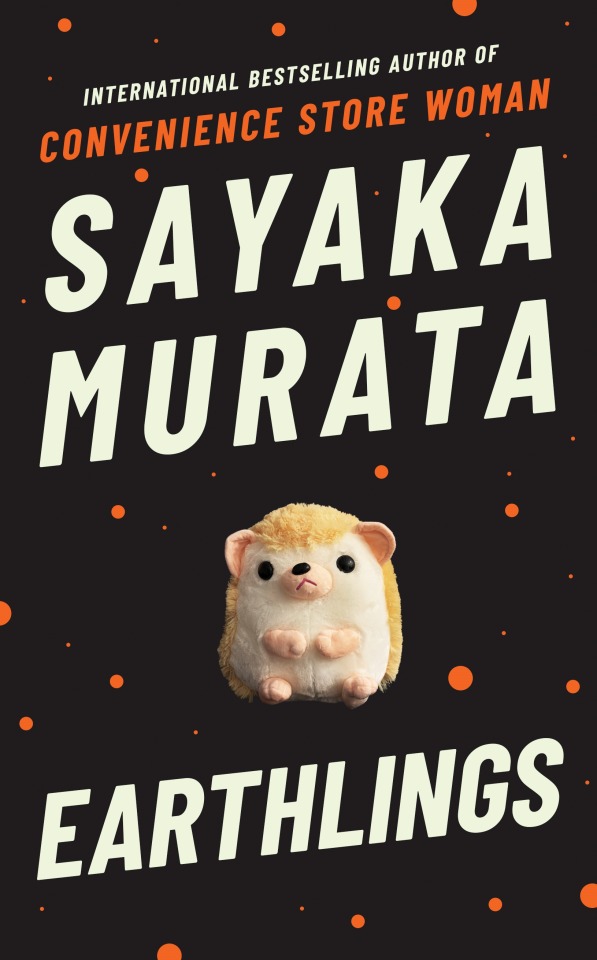
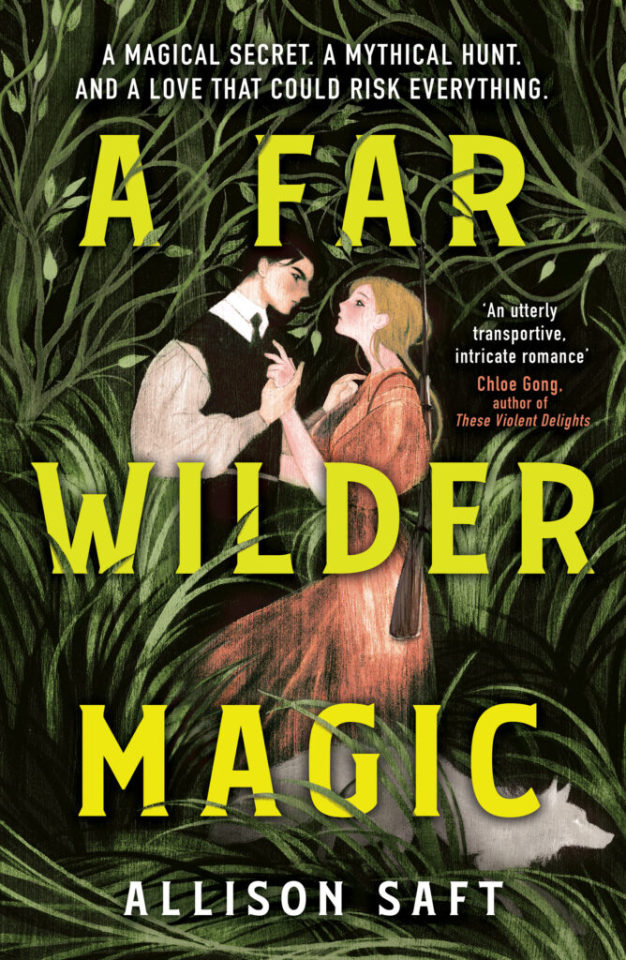
Foundryside - I was so ready. I had the first two audiobooks checked out, I had the third one on hold. I started this but oh, the writing. bleh. I was looking thought reviews and someone referred to it as something like "21st century internet speak." In a high fantasy novel. I noped out at just 10%.
Earthlings - I've considered the author's other book before but haven't read it, but thought maybe a sci-fic book would work better for me? The beginning was odd but not uninteresting, and I might have continued if it had stayed that way. But then the main character was in school(?) and her teacher started getting handsy after class and I wasn't invested enough to stick it out.
A Far Wilder Magic - the success of Something Close to Magic made me a little too hopeful I think, bc while I'm still a little leery around YA, I know people have liked this. And it sounded interesting, truly, and I love the cover. But first it was the religion stuff. And I didn't really like the characters. Then it's like, oh, this is the same plot as The Scorpio Races, but nowhere near it's quality in any shape or form. I decided to stop while I was ahead, before I started to actually dislike it. (anyway here's your PSA to go read The Scorpio Races by Maggie Stiefvater, I recommend doing it in October if you can).
#bec posts#book log#wrap up 2024#books#booklr#book review#the divorce colony#april white#renegades#marissa meyer#hula#jasmine iolani hakes#something close to magic#crying in h mart#lud in the mist#veronica speedwell#pip bartlett#maggie stiefvater#moby dyke#pixels of you#the memory librarian#the djin waits a hundred years
22 notes
·
View notes
Text
Reporting from the Dream Library: Sagas of the Icelanders
This month, the Dream Library is pairing two extremely good first(ish) generation Powered by the Apocalypse games for our TTRPG book club: Gregor Vuga’s Sagas of the Icelanders and Jason Morningstar’s Night Witches. We had our first session (of Sagas) last Friday and it was an absolute hoot — I’ll jump in to talking about everything that happened in just a moment, but first, as a reminder, if you’d like to swing on by for our ongoing RPG book club, play sessions, or just to talk games and design, you should come do that. I will kiss you on the head if you do that (I will not).
Anyway, let’s talk about Sagas.
What is this game like?
Sagas of the Icelanders is an old PBTA game — one of the first generation after Apocalypse World itself. There’s a dedicated subforum on the old lumpley Barf Forth Apocalyptica forums with posts going back as early as 2010, although the full game crowdfunded in 2013. On surface mechanics, it’s a pretty typical MCed 2d6 plus stat mechanical structure, set in the Iceland of the early 900s, a setting which is (to paraphrase the text), as dramatic as high fantasy, as lonely and communal as the post-apocalypse, and as tense with social pressure as a western. We play as a handful of people eking out lives on a broadly unpopulated island, struggling to survive far from their ancestral homes in Scandinavia or the British Isles.
The most immediately eye-catching part of the game is it’s emphasis on gender in society in the setting: almost all of the playbooks in Sagas are gendered, and the basic moves too are divided into those available for men, those available for women, and the (very) few shared between them. It’s a hard swing for a historical game — especially one that came out in 2013 — but, for reasons which I’ll talk about in a moment, it works really, really well.
What was this session like?
Our session opened with, hmm, I would say maybe an hour of loose chatter. I would normally call this a pretty inefficient start to a 3-hour oneshot, but it was honestly worth the time. We were playing with materials designed by Jason Morningstar (of Night Witches) — a family tree with blanks left for us to slot playbooks into. Like the gendered basic moves, this felt good — it hit the right balance between suggestion and restriction — and we spent the first third of our time in what we might call idle dreaming, working to slot our characters into a community together and figure out where things stood. In a real way, the session underscored for me the value of good players — it felt collective and collaborative in a way which required a lot of trust and a good group.
Our first hour of actual play was dedicated on family drama: Vermund, the witchy eldest daughter of a recently deceased goði (a kind of local judge), watched from a cliffside as travelers from another community (a goði named Magni and his daughter, Halla, betrothed to Vermund’s younger brother) picked their way along the road towards our homestead. A wedding should be a time of celebration — yet when she read the runes, Vermund saw danger in the future: a plot by Magni to seize control of the property through this well-timed marriage. To make matters worse, Vermund knows a secret: although Bjorn is in fact her mother’s son, his father is not her father but the Christian thrall, Olan, who was brought back twenty-five years ago from a raid to Ireland.
Back at the homestead, Bjorn and Vermund’s husband, Gisli, relax in a hot spring and are briefly taunted by Egil — a foster-brother adopted by the goði before his death, and several years Bjorn’s elder. After insults fly, a holmgang (a formal duel) is planned for later in the evening, and Egil continues on his way, carrying meat for the welcome-feast for Magni and Halla. Yrsa, the goði’s widow, butchers it herself then assembles the full household to give some sage wisdom on how not to ruin things this evening.
In the last hour of our play, Magni arrived — accompanied not only by his daughter but by a priest — and revealed himself to be a recent convert to Christianity. The welcome-feast settled in more or less peacefully (with some stress over Egil’s seat, which was turned over to Magni’s priest)... although Bjorn did not hit it off with his bride-to-be nearly as well as his sister did. When Egil, motivated by drunken passion and perhaps a legitimate sense of brotherly love, attempted a toast which called more attention to Bjorn’s weaknesses than to his strengths, a brawl broke out between the two brothers which ended — tragically — in Bjorn’s accidental death. We ended our session as Magni’s priest prayed, Yrsa wept, and everyone wondered what could possibly happen to our poor community (and the inheritance) next.
Holy shit did we have a good time. The first and most obvious thing to say — in case it wasn’t obvious from that play summary — is that Sagas of the Icelanders is a deeply social game in a way I think few other games have really successfully mastered. This is where the gendered stuff starts to really come out strong: the playbooks are full of these cascading moves, webs of insult and honor for the men, soft power and tense circumstances for the women, and an altogether sense that things have the possibility to fall apart — or spiral into a blood feud — at any moment. Of course, they eventually did — and in a way I don’t think anyone was expecting. I was excited for the potential of a holmgang, but where we ended up felt somehow more poignant, more tragic and stupid and pointless — and generally more in line with the Icelandic family sagas, the epics from which the game draws its name.
There were friction points, of course — as we discussed afterward in the Dream Library the game, while it does a really terrific job of modeling what it’s like to participate in gendered society, has no real mechanical scaffolding for what it might mean to see yourself outside of the role you’ve been assigned. You can fail at performing gender, of course — but never intentionally subvert it. That being said, the game has a real hack-friendly tone to it (one of the perks of being so early in PBTA as a movement, I think), and I think some custom moves would easily resolve those issues for longer-term play.
Speaking of that hack-ishness, I do also want to shout out that Sagas, like Apocalypse World, has a kind of maximalist sensibility that was eventually lost, I think, from a lot of indie RPGs and has only recently begun to be found again. In the race to prove that indie games are easier to learn than D&D, there’s a tendency to slim down as far as you can — turning thick games into zines and zines into one-pagers — which I think is, genuinely, tragic. Sagas of the Icelanders revels in bits of scale and extra content: historical information, appendices on the legal system during the period and how it changed over time, some mechanics to help ease the transition into a Christian Iceland should your campaign cover the decades that process took, and even a short essay reading Iceland as a successful stateless/anarchist society. There are names, dates, recipes, and snippets — Sagas of the Icelanders is crammed full of little details in much the same way Apocalypse World is.
All in all, it was a really lovely game. I was glad to leave off where we did — and I could have played for another dozen sessions and told the story of multiple generations of this extended family. Sagas is simply good — and more people should be talking about it.
What comes next?
Next on the docket is a oneshot of Night Witches sometime next week as the Dream Library transitions into discussions about that game. I’m really excited — Night Witches, like Sagas, has been on my list for years and I’ve never gotten around to actually playing it. I can’t wait to see how the actual play will shake out. If you’d like to get in on playing, there’s still time! If you just want to come and chat about the game over text, that’s also good! If you’re enjoying reading along with these play reports, well... Keep reading them!
I’ll be back in a couple of weeks with some war stories.
#sagas of the icelanders#powered by the apocalypse#night witches#the dream library#ttrpgs#indie ttrpgs#play report#tabletop rpgs
16 notes
·
View notes
Text
This post is an extension to this post about what can be classified as a BL. I'd rec you read that post first.
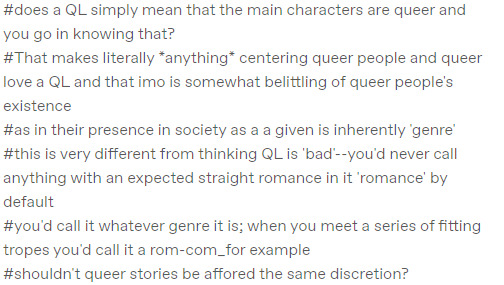
I woke up in the morning with this in my notifs and I just....
Anyway, let's break it down:
Does a QL simple mean that the main characters are queer and you go in knowing that?
First of, in my post I say BL is where you know "Boys are kissing boys and girls are kissing girls." If there is no romance (thus the reference to kissing), the show becomes irrelevant to the conversation.
But to answer: What's wrong with that?
That makes literally *anything* centering queer people and queer love a QL
Great! It's QL.
I've seen this pointed out multiple times have these people wondered why they don't want to call something they think is good a QL? What is wrong with the title of QL?
and that imo is somewhat belittling of queer people's existence as in their presence in society as a a given is inherently 'genre'
Yeah, and Pride and Prejudice is a 'straight genre'
If that doesn't make sense, well, that sentence didn't make sense to me. Does making crime shows make the lives of cops and criminals in to a genre??? It's such an absurd statement. Or maybe I'm just sleepy....
this is very different from thinking QL is 'bad'--you'd never call anything with an expected straight romance in it 'romance' by default
Yeah! That's how it works! Romance is romance. Romance is a genre. It's literally the biggest genre there is. There is more romance written, published, made into animation or live action than literally any other genre by a huge margin.
Romance can and is often combined with other genres. Doesn't change that it is a romance.
you'd call it whatever genre it is; when you meet a series of fitting tropes you'd call it a rom-com
What does rom stand for again?
Romance is often used with other genres, from action to horror to contemporary to fantasy to sci-fi.
This I think primarily comes from people not knowing how genres work. It's not a Boolean (as one would say in computer science). It's not a True/False thing where if it's action it can't be romance. If it's romance it can't be political.
As they say: It contains multitides.
shouldn't queer stories be afforded the same discretion?
Moonlight Chicken, Kinnporsche, Old Fashion Cupcake, Bad Buddy, Love in the Air, Not Me, 180 Degrees, GAP the series, HIStory 3: Trapped, About Youth, Mood Indigo, Cherry Magic, I could go on. You don't have to go anywhere else for it. BL already has it all.
So I'll ask again: Why do you feel that 'BL' is a bad word?
Other people have wrote about this with better sources and much deeper understanding so I'll try my best to convey it here:
As I understand the situation, something got lost in translation when yaoi travelled from Japan to the US and people started understanding yaoi to be a 'dirty' genre, that did not depict honest queerness despite it being made up of majorly queer people. It became the genre that was 'for straight women by straight women'. If you look at US the same phenomenon can be observed when people talk, or at least talked, about slash fiction. Mix in some cultural context and yaoi goes from a fun escapist genre to the bane of queer existence genre. Fiction is enjoyed differently in different parts of the world. Nothing wrong with that. Hell, nothing unique or special with that statement either. It's a fact of life. If Shakespeare can't be universal, as many like to claim, we should not expect the same of anything else.
And let's never forget how westerners think their version of queerness is the only real version. I've had personal experience with this and I can say: People need to open their minds and understand that not everything is from their perspective. When I encounter any American thing in a show or book, I simply slide past it because I'm not American. I've never been to America. It doesn't change the story itself, so why bother, what would be the point. If people applied that approach instead of analyzing every detail and expecting it to fit your world view then we would all be happier.
(It turned sappy at the end there. I'm sleepy.)
#Moonlight Chicken#Kinnporsche#Old Fashion Cupcake#Bad Buddy#Love in the Air#Not Me#180 Degrees#GAP the series#HIStory 3: Trapped#About Youth#Mood Indigo#Cherry Magic#manner of death#long post#only friends#wedding plan#laws of attraction
66 notes
·
View notes
Note
hi bee :) semi-new anon here just hoping that you’ve been doing okay <3 i wanted to say that i absolutely adore your writing, and will happily read it, no matter what fandom it is you’re writing for, or if you’re just writing original works /gen!! your writing has always inspired me heavily hehe, it’s wonderful.
also, on the topic of original works, do you have any good novel recommendations? i’ve recently gotten back into reading and have been super into fiction, but i’m down for any sort of recs. one of my favourites at the moment is good omens :)
here’s your daily message to go have some water or tea and take care of yourself !! 🌷
hello hello!! I'm doing pretty alright now, feeling a lot better than I was this past week :) and that's so sweet of you to say, it's so reassuring knowing I have so many of you guys willing to read my silly stories no matter which fandom they're about (or even if they're original)
and yes I do have some recs!
I made a post about two months ago now talking about books I'd read that I really enjoyed so there'll be some crossover here but also some new ones I've read since then
one of my new favorite novels is The Priory of the Orange Tree by Samantha Shannon. it's a heavy fantasy story following 4 different intertwining POVs. the fantasy world itself is made up of several different countries all inspired by various real world cultures that's not just limited to western europe which is incredibly refreshing. the world itself is incredibly fleshed out and interesting, the characters are all very diverse and have so much depth, and there's also a very beautiful sapphic romance <3 I'm reading the prequel to priory right now and I'm also loving it so far
another book I really enjoyed is actually a duology—The Radiant Emperor series by Shelley Parker-Chan. the first book in the series is She Who Became the Sun which I really enjoyed, however the sequel book He Who Drowned the World is the one that absolutely blew me away. just letting you know in case you're not comfortable with it, both books contain sex and some graphic violence. the story is set in 14th century China when it was ruled by the Mongols, and it's an incredibly well done queer retelling/fictionalization of the rise of Zhu Yuanzhang, the Emperor who ushered in the Ming dynasty. the text engages with so many themes of the expectations of masculinity and femininity and how they restrict people, and really dives into gender expression and how it can be wielded in different ways. again the first one was really enjoyable, but the second one was on a whole other level and I'm still reeling over how good it was and how much it emotionally hurt me.
ok and then last one for now
This is How You Lose the Time War by Amal El-Mohtar and Max Gladstone - I know we all heard about this one thanks to the iconic bigolas dickolas wolfwood on twitter but also they were so right about this book. it's gorgeously written. the book itself is mostly written as letters exchanged between two women who are time traveling agents on opposing sides of a war for who controls the timelines. it's a beautiful love story, it's sci fi but with a heavy bend towards spec fic which I personally really like, the world concepts are incredibly fascinating, and it plays around with time travel in a very intriguing way. it's a very short book so it's an easy one to burn through. I checked this one out from my library but I'm highkey tempted to go to a bookstore and actually buy a physical copy for myself just because there were so many gorgeous lines I want to highlight
hope this helps!! my taste in books is usually: sci fi/fantasy/spec fic with sapphic women so hopefully that's something you enjoy as well lmao
19 notes
·
View notes